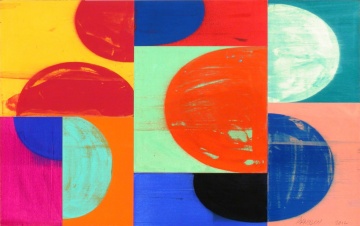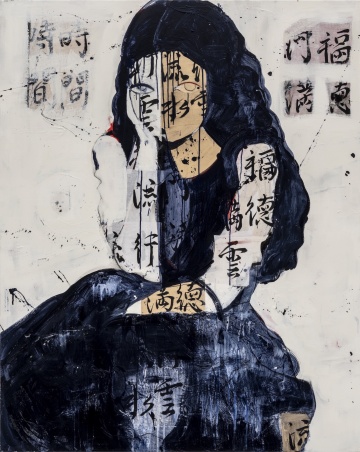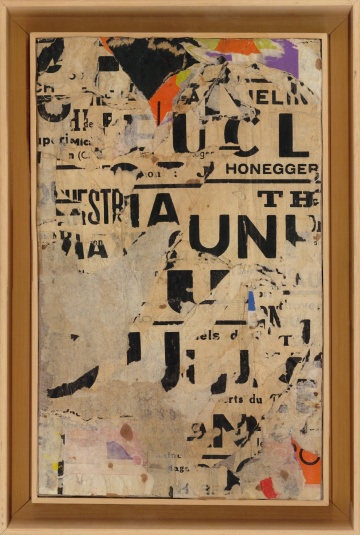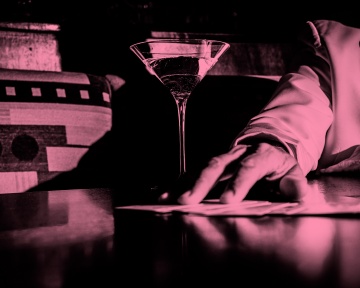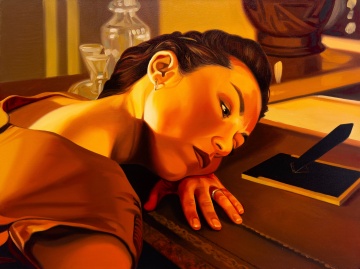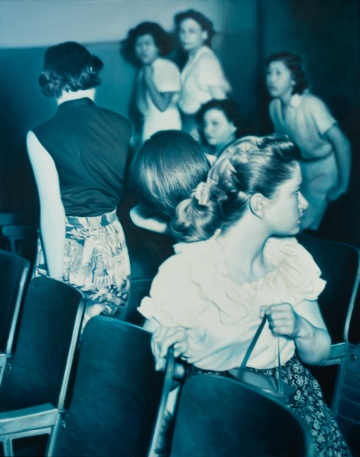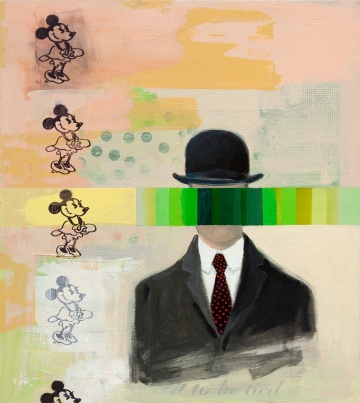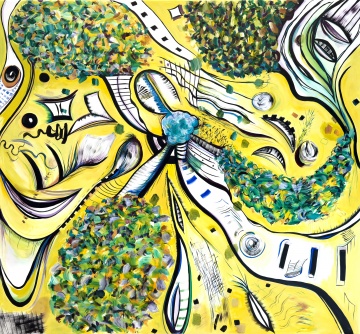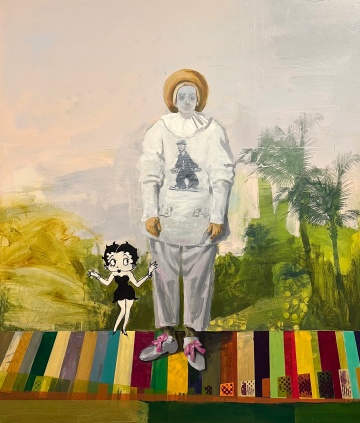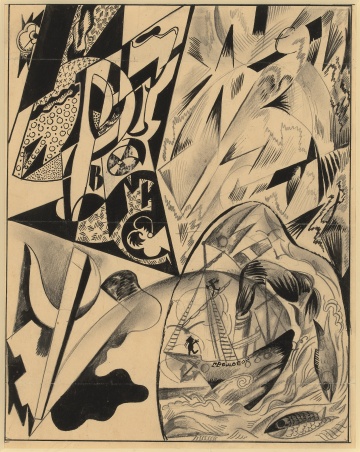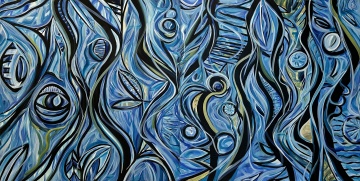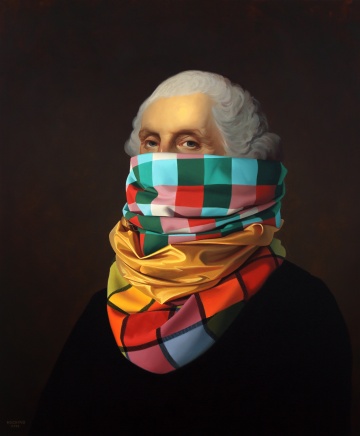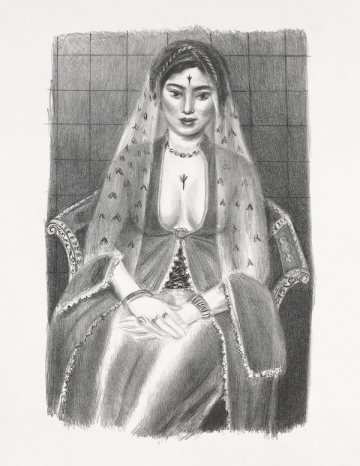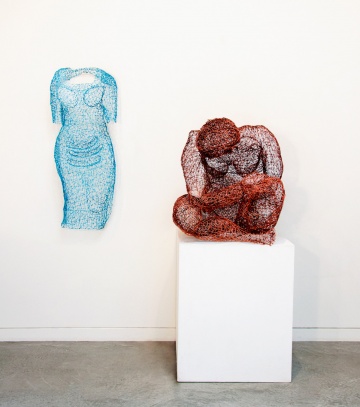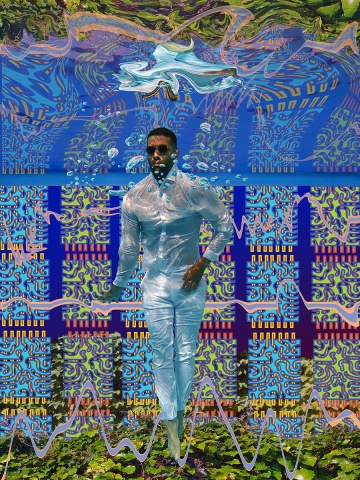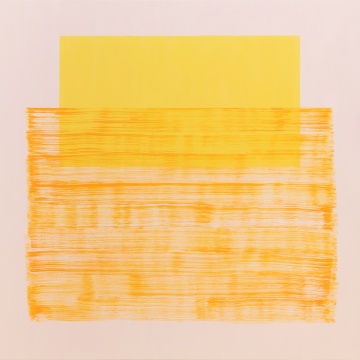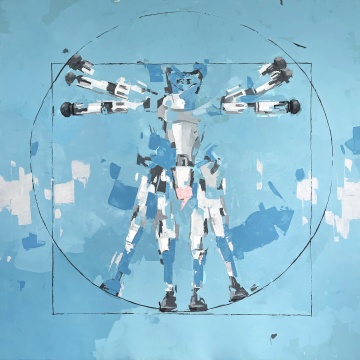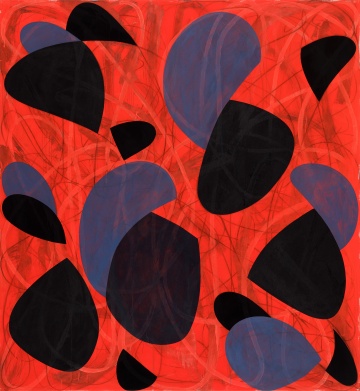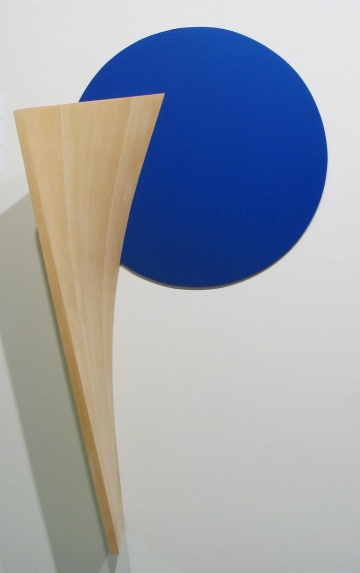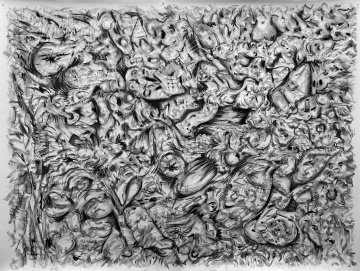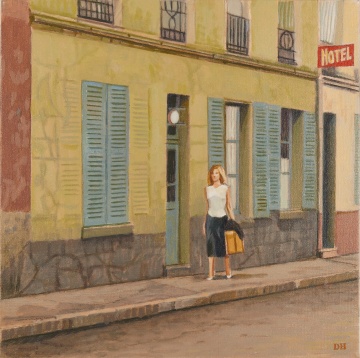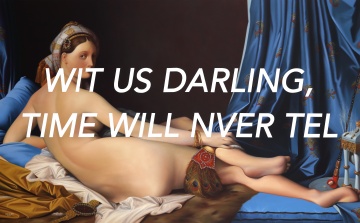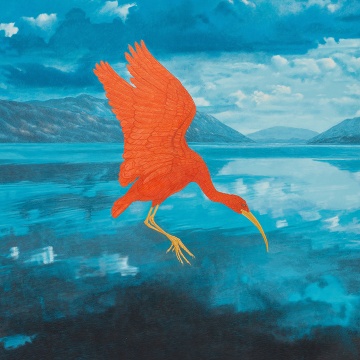Modernism Inc.
724 Ellis Street
San Francisco, CA 94109
415 541 0461
Also at:
Modernism West
2534 Mission Street
San Francisco, CA 94110
415 541 0461
San Francisco, CA 94109
415 541 0461
Also at:
Modernism West
2534 Mission Street
San Francisco, CA 94110
415 541 0461
Over the past four decades, Modernism has presented more than 500 exhibitions, featuring an international roster of historical and contemporary artists. The museum-quality program, overseen by gallery founder and owner Martin Muller, includes conceptually challenging and aesthetically rigorous painting, photography, sculpture, video, performance art, and works on paper.
Since 1979, the gallery has been at the forefront of the art world, presenting a retrospective of the Russian Avant-Garde in 1980 – before any other West Coast gallery or museum showed the historically-important work of Russian Avant-Garde artists – and staging the first Bay Area gallery exhibition of Andy Warhol in 1982. Both abstraction and figuration have been central to the gallery program ever since. In addition to 17 more Russian Avant-Garde exhibitions, Modernism has shown the work of the Southern California abstractionist James Hayward since 1980, and recreated “Four Abstract Classicists”, a seminal 1959 Los Angeles County Museum of Art exhibition, in 1993. At around the same time, the gallery introduced America to the politically-charged conceptual works of Austrian-born multimedia artist Gottfried Helnwein.
In the 21st century, Modernism has continued to open new frontiers in the Bay Area art world. The historical program now encompasses Dada, Cubism, Surrealism, Vorticism, and German Expressionism, as well as the Russian Avant-Garde. Historical landmarks have included the first major West Coast retrospective of Le Corbusier in 2003, and the first major American exhibition of paintings, drawings, collages, and photographs by Erwin Blumenfeld in 2006. Over the past decade, Modernism has staged notable retrospectives of key modern artists including Edvard Munch, and historically important contemporary artists and photographers including Mel Ramos, John Register, Jacques Villeglé, and Judy Dater.
Representing nearly fifty contemporary artists from around the world, the gallery contributes to current artistic dialogues, both representational and abstract, with several dozen shows per year presented at both Modernism and Modernism West, as well as art fairs in North America and Europe. Areas of focus include conceptual and textual work, and art that meaningfully addresses important sociopolitical concerns.
The gallery regularly publishes books, monographs, catalogs, and fine art editions, including notable volumes about gallery artists Mel Ramos, Naomie Kremer, Gottfried Helnwein, Elena Dorfman, Charles Arnoldi, and Jacques Villeglé.
Artists Represented:
Alex and Mushi
Elina Anatole
Charles Arnoldi
Edith Baumann
Glen Baxter
Jean-Charles Blais
Lucien Clergue
Judy Dater
Elena Dorfman
Michael Dweck
Damian Elwes
Sheldon Greenberg
Philippe Gronon
Duncan Hannah
Gottfried Helnwein
Tony Hernandez
Scot Heywood
Raymond Holbert
Shawn Huckins
Bill Kane
Jerry Kearns
Jonathon Keats
Naomie Kremer
Eva Lake
Laurie Lipton
Peter Lodato
Kristine Mays
Lindsay McCrum
Yang Mian
John M. Miller
Alex H. Nichols
Andreas Nottebohm
Patti Oleon
Agnieszka Pilat
Mel Ramos
John Register
Peter Sarkisian
Ben Schonzeit
David Simpson
Stephen Somerstein
Robert Stivers
Mark Stock
Sam Tchakalian
Mark Ulriksen
Jacques Villeglé
Stéphane Zagdanski
Works Available By:
Erwin Blumenfeld
Alexander K. Bogomazov
R. Crumb
Albert Gleizes
Ivan V. Kliun
Frederick Hammersley
Henri Hayden
James Hayward
George Koskas
Le Corbusier
Kazimir S. Malevich
Albert Marquet
Ilya I. Mashkov
Edvard Munch
Ivan A. Puni
Georges Valmier
Andy Warhol
Robert Wilson
Kirill M. Zdanevich


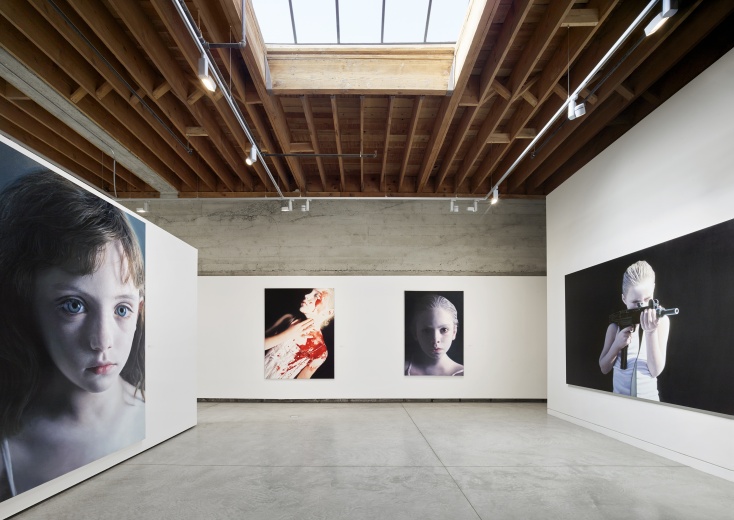
Modernism Gallery - Interior 2
Modernism Gallery - Exterior
Modernism Gallery - Interior
Group Show
Second Nature
September 4, 2025 - November 1, 2025
FEATURING: ALEXANDMUSHI, UTA BARTH, LAUREN BARTONE, MICHAEL BRENNAN, DEBORAH BROWN, GORDON COOK, EDWARD CURTIS, JUDY DATER, ELENA DORFMAN, ALAN DRESSLER, MICHAEL DWECK, DAMIAN ELWES, SHELDON GREENBERG, EMANUEL GYGER, JAMES HAYWARD, WADE HOEFER, SHAWN HUCKINS, JERRY KEARNS, SAMEH KHALATBARI, NAOMIE KREMER, LOUISE LEBOURGEOIS, KRISTINE MAYS, LINDSAY MCCRUM, JOHN NAVA, ROBERT PARKEHARRISON, SARAH PERRY, ANDRÉ RACZ, MEL RAMOS, JOHN REGISTER, MICHAL ROVNER, NAOMI ALESSANDRA SCHULTZ, CAMILLE SOLYAGUA, ALBERT STEINER, MARK STOCK, HIROSHI SUGIMOTO, SAM TCHAKALIAN, DAVID TROWBRIDGE & HELENA CHAPELLIN WILSON
Nature has arguably been the favorite subject of artists since the beginning of time. While some artists dedicate their practice to portraying the natural world as it appears with accuracy, others use nature loosely as a muse or starting point to employ their artistic processes. In today’s world where we are inundated with content of nebulous artificiality, questioning "is this real or fake" has become second nature. While artists continue to use nature as a subject and inspiration, the question "is this nature or is this a product of a human intervention" feels more pertinent than ever when viewing art and imploring so feels instinctual.
Modernism is pleased to present "Second Nature," a group show of 50 artworks from 1900 to contemporary, which explores the indeterminate boundary between the organic and the constructed. The exhibition brings together works that appear to authentically depict nature with seemingly blatant manipulations of the natural world. As the organic is transformed and artificial compositions mimic nature, "Second Nature" invites viewers to reconsider the divide. What appears raw may be refined and what seems fabricated, unexpectedly true to nature.
The conundrum lies within the art itself, as the appearance of the work often does not reveal the truth of its authenticity. For example, Hiroshi Sugimoto’s "Devonian Period" seems to be a genuine black and white photograph of coral reef. The viewer would likely believe so, unless they were aware the image is from his "Dioramas" series, a body of photographs taken of museum exhibits. What appears to be a live and bustling ocean floor is actually a still display of marine life replicas behind glass, not submerged in water. While seemingly more real than the colorful flora scene of Damian Elwes’s "Amazon Cloud Forest," one could argue that Elwes’s depiction of nature, while stylistically expressionist, is closer to real nature. Created in response to the colors of the exotic vegetative landscape he experienced when hiking a volcano in Colombia, Elwes’s composition is only once removed from the original. Sugimoto’s, on the other hand, is twice removed from its original, since the photograph is a depiction of a depiction of nature. Complexities such as these are dissected throughout the exhibition.
Perhaps then we can only consider depictions of nature once removed as natural. In doing so, we would look to the sober landscapes of John Register. Both "Hanalei Bay" and "Study for Further Lane" present as earnest scenes of American Realism, taken from real places in the world. However, when we consider Register’s signature process of meticulously redacting nonessential visual information to produce a more simplified distillation of the original subject, the viewer is left to wonder how true to nature his landscapes really are. Similarly, the two soft-focus photographs from Uta Barth’s "Ground" series featured in the exhibition present natural landscapes, but with so much detail blurred, the classification as real nature feels complicated.
The tightly cropped composition of Mel Ramos’s watercolor "Salou," which depicts the underside of fronds of two palm trees, is rendered in such detail that categorization as organic nature seems probable. But even if "Salou" was composed from a photograph or was a genuine plein-air study, the sterile state of the two trees hardly coveys "natural," rather, a man-made and regularly manicured paradise resort. Without the context of their surroundings the viewer is left to speculate.
Some works in the exhibition erode the original context of natural forms to such a degree that they no longer read as nature despite being so conceptually rooted in it, like Sameh Khalatbari’s "Fly of a Lifetime" and Naomi Alessandra Schultz’s "Still Life with Clippings and Waste Bin." The deconstructed depictions of pastoral scenes by Shawn Huckins and Michael Brennan, though rendered with masterful realism, border surrealism in their composition and the mind refuses to compute them as natural.
Other works also modify organic forms but they still read as nature. The digitally stitched photographic tapestries of Lindsay McCrum and Elena Dorfman are clearly of human invention, but their natural origins remain undeniable.
In addition to manipulating nature in form, artists in the exhibition also manipulate nature as material. In "Transmutations 1" Dorfman incorporates metals and minerals native to the places pictured in her photographs to root the work in the land it originated from and to explore the relationship between human and nature. Lauren Bartone utilizes organic material like fustic wood and the cochineal insect to dye the linen used in "Empire."
Other artists in the exhibition also use raw nature as material such as Naomi Alessandra Schultz in her installation piece "Flagged Hedge" composed from branches and David Trowbridge’s wall sculpture "Psalm #144" crafted partially from a tree. Is it possible organic matter as material is the closest we can get to an actual representation of nature? Or does the act of alteration automatically render it unnatural?
Other works in Second Nature propose the possibility that human intervention does not inherently make depictions of nature unnatural. After all, aren’t humans, after stripped of their modern adornments, organic forms? Amongst the nature-or-not paradoxes present in the many of the other works in the exhibition, artworks featuring humans, even though posed, may seem to be the most natural of all. Judy Dater’s "Self-portrait with Petroglyph" reads prehistoric. Michael Dweck’s "Mermaid 162, Aripeka" reminds us of the inseparability of human and nature and ALEXANDMUSHI’s "Two Chairs, Giant Rock, Joshua Tree," our position in relation to it.
Or perhaps nature simply cannot truly be portrayed representationally at all and every depiction is inherently artificial. In painting a bird, like Jerry Kearns’s "SWOON," it ceases to be a bird. While airborne, Kristine Mays’s sculptures do not become any more real than a bird painted on canvas. Does the process of recreating an image from the natural world, only cause further separation from the organic form it represents? Is every depiction of nature a simulacrum? If so, nature cannot be conveyed authentically with visual forms. Perhaps the truest portrayal of nature in art is nonfigurative and Naomie Kremer’s enveloping canvases of gestural abstract marks, inspired by nature, yet still abstract, may be the closest we can achieve to the actual experience of nature.
Through material, process, and form, artists in "Second Nature" create confounding contradictions: natural but not, nature but also artificial. In portraying the natural world, rather inauthentically, a sort of “second nature,” i.e. not the original, now once or even twice removed, emerges. And asking the question "is it nature or not" is only second nature.
Text and exhibition curation by Asa Perryman
THE PUBLIC IS INVITED TO AN OPENING RECEPTION ON THURSDAY, SEPTEMBER 4TH FROM 6:00-8:00PM
Gallery Hours: 10am-5:30pm Tuesday-Saturday
FOR FURTHER INFORMATION CALL: 415-541-0461 OR EMAIL: INFO@MODERNISMINC.COM

Helen Kim
Story Lines
August 22, 2025 - October 25, 2025
Modernism is pleased to present seven paintings and nine works on paper by Sheldon Greenberg in "Syncretic Overlays." Reminiscent of Robert Rauschenberg, Greenberg appropriates familiar iconography to pay homage to masters who have shaped artistic expression and to explore how their influence resonates in contemporary practice.
The paintings borrow imagery from Old Masters such as Jean Siméon Chardin’s "Boy with a Spinning-Top" (1738) and Modern Masters like Edgar Degas’s "Race Horses" (c. 1885-1888), Gustav Klimt’s "The Kiss" (1908), Henri Matisse’s "Large Reclining Nude" (1935), and Balthaus’s "Les Enfants Blanchard" (1937) and "Thérèse sur une banquette" (1939). Having admired these historic paintings for decades, Sheldon Greenberg wonders whether they might gain new admirers if they were to be reconceived as contemporary art. In pursuit of this question, Greenberg critically broke down what he saw and systematically reconstituted the most fascinating elements in his own contemporary style.
The works on paper offer us insight into Greenberg’s process. While at first glance many appear seemingly abstract, peering through translucent layers of color, the images obscured beneath almost become visible and the artist’s method of redacting visual information to create a more complex amalgamation is revealed.
As eclectic as these works may be, Greenberg has unified them through his use of visual devices carried over from his previous bodies of work. Principal among these are his use of silkscreens, stripes, polka dots and mute charts. The silkscreens are especially important on both a visual and conceptual level. Often taking Greenberg’s photographs of palm trees as their subject, they provocatively disrupt the traditional spatial organization of paintings from past centuries, in addition to distorting the viewer’s sense of time, as they employ a photographic process that didn’t exist in the era of Chardin.
Named after well-known songs from pop culture, Greenberg’s paintings recontextualize landmark works from the canon to offer the viewer an opportunity for a postmodern reconsideration of the works’ cultural, personal and temporal meanings.
Sheldon Greenberg was born in Shreveport, Louisiana in 1956. He studied at the Art Students League in New York from 1985-86 and received an MFA from California College of the Arts & Crafts, Oakland in 1994. His work has been shown across the nation and at museums including the de Young, the San Diego Museum of Art and the Crocker Art Museum in Sacramento. Greenberg has taught painting at The Academy of Art in San Francisco since 2003. He now lives and works in Oakland, California.

Sheldon GREENBERG
Syncretic Overlays
August 22, 2025 - October 25, 2025
Modernism is pleased to present seven paintings and nine works on paper by Sheldon Greenberg in "Syncretic Overlays." Reminiscent of Robert Rauschenberg, Greenberg appropriates familiar iconography to pay homage to masters who have shaped artistic expression and to explore how their influence resonates in contemporary practice.
The paintings borrow imagery from Old Masters such as Jean Siméon Chardin’s "Boy with a Spinning-Top" (1738) and Modern Masters like Edgar Degas’s "Race Horses" (c. 1885-1888), Gustav Klimt’s "The Kiss" (1908), Henri Matisse’s "Large Reclining Nude" (1935), and Balthaus’s "Les Enfants Blanchard" (1937) and "Thérèse sur une banquette" (1939). Having admired these historic paintings for decades, Sheldon Greenberg wonders whether they might gain new admirers if they were to be reconceived as contemporary art. In pursuit of this question, Greenberg critically broke down what he saw and systematically reconstituted the most fascinating elements in his own contemporary style.
The works on paper offer us insight into Greenberg’s process. While at first glance many appear seemingly abstract, peering through translucent layers of color, the images obscured beneath almost become visible and the artist’s method of redacting visual information to create a more complex amalgamation is revealed.
As eclectic as these works may be, Greenberg has unified them through his use of visual devices carried over from his previous bodies of work. Principal among these are his use of silkscreens, stripes, polka dots and mute charts. The silkscreens are especially important on both a visual and conceptual level. Often taking Greenberg’s photographs of palm trees as their subject, they provocatively disrupt the traditional spatial organization of paintings from past centuries, in addition to distorting the viewer’s sense of time, as they employ a photographic process that didn’t exist in the era of Chardin.
Named after well-known songs from pop culture, Greenberg’s paintings recontextualize landmark works from the canon to offer the viewer an opportunity for a postmodern reconsideration of the works’ cultural, personal and temporal meanings.
Sheldon Greenberg was born in Shreveport, Louisiana in 1956. He studied at the Art Students League in New York from 1985-86 and received an MFA from California College of the Arts & Crafts, Oakland in 1994. His work has been shown across the nation and at museums including the de Young, the San Diego Museum of Art and the Crocker Art Museum in Sacramento. Greenberg has taught painting at The Academy of Art in San Francisco since 2003. He now lives and works in Oakland, California.
THE PUBLIC IS INVITED TO A RECEPTION FOR THE ARTIST TUESDAY, OCTOBER, 21, 6-8PM
Group Show
Selected Abstract Works
July 17, 2025 - August 22, 2025
Modernism is pleased to present a selection of 11 paintings by contemporary Modernism artists addressing a range of ideas, all expressed with an abstract vocabulary.
The exhibition includes work from living artists, both new and familiar, ranging from long standing cornerstones of the gallery’s programming, like James Hayward and Naomie Kremer whose history with Modernism harks back to before the turn of the millennium, to very recent additions to the roster such as Sameh Khalatbari and Victor Reyes. Though connected by the loose thread of abstraction, the works range from the formal abstraction of Edith Baumann to the lyrical abstraction of Macha Poynder. In the exhibition, white monochrome paintings are juxtaposed with compositions of explosive color. Monumental paintings that tower over and envelop the viewer neighbor small works that invite the viewer in for closer examination.
The exhibition’s contrasts are not only aesthetic, but conceptual as well. Works, like those of Charles Arnoldi, focus on iterative visual qualities and the correlative experience of form and color, while others symbolize nonfigurative narratives. Some narratives are political such as Sameh Khalatbari’s "1401 N/m2 Resistance – No.1 Resistance," a large-scale mixed media painting created in response to the death of Mahsa Amini and the ongoing conditions of gender apartheid in Iran. In this work, bands of bound cord are restrained and reshaped by the physical tension of opposing cords, symbolic of the Iranian women Khalatbari represents in her work.
Other narratives are socio-anthropological like Victor Reyes’s enormous diptych "Silent Hart of the Earth" which recalls the San Francisco of decades past and tells the story of its jarring convergence with the ever-changing city of present day. The layered forms, created by a meticulous sequence of screens and molds, echo the multi-layered personality of the place by which it was inspired.The abstraction of place and memory does not end with Reyes. Naomie Kremer translates personal experiences and observations of nature, into a visual language that makes the real unrecognizable, echoing the processes of Ellsworth Kelly and Brice Marden.
Like Naomie Kremer, Edith Baumann’s paintings also are personal, though they are not self-referential. Much like Mark Rothko, Baumann utilizes economy of means in her zen-minded minimalist paintings, beckoning the viewer not to ponder the artist, but the self.
In contrast to the simplicity of Baumann’s formal abstraction, Hayward’s topographically rich gestural impasto paintings embrace the lyrical abstraction of Jackson Pollock and Willem de Kooning, but with the austerity of ivory hues.
The inclusion of such diverse work presents a brief continuum of Modernism’s history in presenting the abstract. From Modernism’s conception and very first exhibition, abstraction has served as a primary pillar of the gallery programming. Whether formal or lyrical, vibrant or muted, large or small, Modernism is proud to celebrate the nonobjective in all its variety.
Alex H NICHOLS
SHOCK whisper
May 22, 2025 - July 31, 2025
Modernism is pleased to present "SHOCK whisper," an evocative new series of paintings and installation by artist Alex H Nichols. Rooted in introspection and vulnerability, Nichols’ work explores the fragmented nature of memory, identity, and recovery—inviting viewers into an intimate process of reconstruction and self-discovery.
Through bold yet gentle gestures, Nichols weaves narratives of personal and collective histories. Her paintings begin as fragments—fragments of sentences, fragments of form, fragments of self—and build toward an elusive wholeness. She describes her process as retrieving pieces of herself, creating a world of Indigo. Using a limited palette of ultramarine blue, burnt umber, mars black, and powdered charcoal to plunge into deep, contemplative spaces. Black inside blue. Brushing blue, the excess water falls downward evoking the sensation of memory rising and falling, expanding and contracting, as she confronts the quiet truths of her past.
Nichols’ paintings confront questions of trauma, recovery, and psychological safety: "When I am in shock, I need a space where I can retrieve myself," says Nichols. “Why blue? Blue is the blue rug of my childhood cast in moonlight when everyone is asleep, blue in my childhood is imagination, blue is safety.”
In "SHOCK whisper," viewers encounter not only the visible figures and shapes that emerge from her canvases but also the hidden, internal landscapes they represent. Nichols uses the rich symbolism of blue—reminiscent of the blue rug cast in moonlight from her childhood evoking imagination, dreams, and safety—to create a space of refuge, a contemplative arena for soul retrieval. Here, art becomes a tool for individuation, echoing shamanic traditions and Jungian psychology.
Join us at Modernism West to explore this profound exhibition that asks us all: “how do we gather the fragments of ourselves after shock, whether personal or political, and how do we rebuild?”
THE PUBLIC IS INVITED TO A RECEPTION FOR THE ARTIST THURSDAY, MAY 22, 6-8PM
Helen Kim
Elasticity of Color
May 8, 2025 - July 9, 2025
As a youth, Helen Kim was intrigued by the beauty of the art on display. Set high on the wall above the chalkboard, the twenty-six drawings were unlike anything she’d ever seen growing up in Korea. Learning that the drawings were the alphabet, she was elated, and even more delighted when she learned to draw the letters for herself. “When I eventually learned cursive, I was lauded for my beautiful penmanship,” she recalls. “It felt like I was drawing.”
Decades later, handwriting remains central to Kim’s artistic practice, an essential dimension of oil and cold wax paintings that contain layers of inscrutable lettering in conversation with saturated color fields. Modernism is pleased to present 39 recent works in "Elasticity of Color," on view from May 8th to July 9th.
In addition to the memories of the alphabet, Kim is deeply influenced by the material world of her childhood. She was especially taken by the vibrant colors of traditional Korean clothing, and the saturated hues of silk gift pouches containing money or jewelry, as notable for the ornate designs of the fabric as the objects they contained. She recalls the bright colors of persimmons, apples and pears, set out on ceremonious occasions. “I was intrigued by the offset, repetitive pattern of the organic shapes.”
Inspiring the title of this exhibition, these memories and colors are embedded in her paintings, often reflected in names such as "Persimmons" and "Hopscotch." Even if the viewer is unfamiliar with the specifics, the specificity of the memories is apparent, and leads the viewer to vicariously experience the artist’s feelings and thoughts, past and present.
Like memories, the paintings have many layers. Kim begins with a single color. After applying a field of paint to the panel, she draws with oil sticks, often inscribing unprompted words that come to mind. Frequently drawn with her non-dominant hand, the letterforms serve as the first move in a visual puzzle that Kim works through by alternate layers of color and line until a solution is reached.
The result is a sort of palimpsest replete with pentimenti. Kim sees the process as “about the interpretation, exploration and execution of an idea,” every stage of which is preserved in the depth of oil and cold wax. Kim’s training as an architect informs her process and the crossover between art and architecture is apparent in her work. In each painting, Kim builds a visual world through the give and take of personal marks, discovering novel structures to scaffold her past.
Kim uses various mediums- paint, drawing and knitting- to recall memories into the present. In works such as "Stockinette," she knits compositions that stand beguilingly between two and three dimensions. Even before she mastered the alphabet, Kim learned knitting from her maternal relatives. “I remember the common bond, and the meditative feeling that came from the repetitive motion of connecting loops,” she says. “The linear process is the same for knitting and painting, both of which create complexity through layers of color.”
The complexity lies beyond the reach of words. “My life’s stories are visually narrated and abstracted in my paintings and knitting,” Kim explains. “These memories and events, which have shaped who I am, are the conceptual catalyst for my art.”
THE PUBLIC IS INVITED TO AN OPENING RECEPTION ON THURSDAY, MAY 8TH FROM 6:00-8:00PM
Jacques VILLEGLÉ
Urban Language
May 8, 2025 - June 9, 2025
Modernism is pleased to present its ninth survey of seminal French contemporary artist Jacques Villeglé [1926-2022]. "Jacques VILLEGLÉ: Urban Language" examines twenty-five décollage masterpieces by this influential Nouveau Réaliste, through the lens of typography.
EXCERPTS FROM "JACQUES VILLEGLÉ AND THE STREETS OF PARIS" BY BARNABY CONRAD III
<< Villeglé spent most of his life wandering the streets of Paris, pulling torn advertising posters off the ancient walls and pronouncing them Art. "In seizing a poster, I seize history, he says. "What I gather is the reflection of an era."
Born in Brittany in 1926, Villeglé was a seventeen-year-old architectural apprentice in Nantes during the bleak days of the German Occupation. After the Liberation in 1944, he moved to the City of Light, where he was drawn to filmmaking, avant-garde Lettrist poetry, and painting. The prewar art movements of Cubism and Surrealism had melted into abstraction, but Villeglé’s earnest attempts at Art Informel soon struck him as redundant, and he destroyed his canvases. Without a job and at loose ends intellectually, he became a "flâneur," a curious intellectual roaming through war-scarred Paris. “As I walked through the streets, I was struck by the color and typography of the posters. In those days, the cinema and concert posters rarely had images—just words—and they had been torn and shredded to where they became something else, with a post-cubist look to them. I began to see them as paintings made by anonymous hands.”
Villeglé recalled, "Even as a young student, I was always interested in typography.” In early 1940s France, Villeglé attended an exhibition of prewar posters by Paul Colin, Jean Carlu, Cassandre, and other artists at the Galerie Charpentier opposite the Palais de l'Élysée. “I could see that the poster artists had a dialogue with the cubist painters of their time. Most fascinating for me was the poster typography, the lettering itself. Months later, I returned to that gallery and bought the exhibition catalogue.” Villeglé kept this catalogue in his possession up to his passing.
An avid reader, Villeglé was poking around a bookstore one day when a book caught his eye and he bought it on sale for a few francs. It was poet Blaise Cendrar's novel "La Fin du monde, filmée par l'Ange N.D.," illustrated by Fernand Léger. "The text was printed in a font used in foreign posters actually, Cheltenham gras—and Léger's illustrations were in primary colors," he recalled. "I was amazed to see this book had been printed in 1919. It seemed so modern, so fresh. It made me want to do something in the art world that was this bold."
“After the war, I learned that posters inspired Stéphane Mallarmé for his poem 'One Toss of the Dice Will Never Abolish Chance.' Mallarmé was the pure poet. He composed his poems thinking about the compositions of posters for theater and advertising. I also knew that Georges Braque introduced letters into his cubist paintings, like 'Le Portugais' in 1912. Early on I believed that letters gave structure to posters on an abstract level, and I looked for that in the posters I took.”
In 1949, Villeglé and his then artistic collaborator and life-long friend, Raymond Hains [1926-2005], began scavenging advertising from billboards on the grand boulevards, snatching political posters in the financial district, and pillaging Left Bank walls plastered with flyers for jazz concerts and art exhibitions. Mounting them on canvas, they presented them as a new kind of art. Between 1949 and 2003, Villeglé himself plucked more than 4,500 works from all twenty of Paris’s arrondissements, carefully labeling each with the exact date and street address of the poster’s origin. Each work became a unique time capsule of the ever-changing city.
This selective collector of torn posters casually explained his impulsive modus operandi: "These are very rapid decisions. François Mauriac once said you should write like a sleepwalker. Was it the same for me with posters? If you see something in the street, you have no time to meditate. You strike fast, like a photographer, in less than a second, and worry about it back in the studio."
Villeglé's collecting habits may have been impulsive, but early on he understood that he had tapped into an enormous river of expression. "I realized right from the start that lettering would change, that new colors would be developed, that photography would be employed someday. Electric blue didn't exist, for instance. So right from the beginning I saw this material would be historic and would constitute an archive, a ragged memory of our era."
Such a time capsule of typography, "Les Dessous du Quai de la Rapée," 21 mai 1963, appears to be an alphabet composed of tipsy, deformed letters. At the top of the picture, the words "Beaux-Arts" have been torn to spell "Faux Arts" - fake arts. Further observation reveals fragments of concert announcements for Beethoven, Rossini, Mozart, De Falla, and even Gershwin's "Porgy and Bess" and "An American in Paris." The letters bob in a cacophonous universe that evokes the Lettrists' typographical obsession and such Russian avante-garde artists as Iliazd (Ilya Zdanevich).
The Lettrists said that poetry was made not simply of ideas or words, but of letters that could be scrambled and manipulated into new words and sounds. Villeglé and Hains went a step further: they saw that letters were ultimately graphic elements that could be distorted by human hands, whether through torn posters or by a camera lens.
In 1953, Hains and Villeglé used Hains's hypnagogoscope (an original camera invention which abstracts images and words) to distort Camille Bryen's 1950 tone poem, "Hepérile," into strange, otherworldly shapes that twisted and slithered across the page like an indecipherable chameleon alphabet. No one could read it, but it was interesting to look at. They printed it as a small book in a limited edition. Titled "Hepérile éclaté," it became a hit in avant-garde circles. Even the great cubo-futurist typographer "Iliazd" (Ilya Zdanevich) got hold of a copy and raved about it. In a text circulated at that time, Villeglé wrote, "Les Lettristes ont fait éclater le mot, Les Hepérilistes font éclater la lettre" (The Lettrists shattered the word, the Hepérilists shatter the letter.) >>
Villeglé’s work reads like a palimpsest—found, effaced and recontextualized. Inspired by Mallarmé’s spatial poetics, Léger’s bold modernism, and the Lettrists’ deconstruction of language, Villeglé used typography not as a medium to express meaning, but as material, abstract yet archival. Torn type, disjointed letterforms, and unintended alignments erode syntax so that a letter becomes more than a component of a word, and instead a visual historical record.
Jacques Villeglé’s work has been exhibited extensively in the United States and Europe, and is the collections of many important museums worldwide (Museum of Modern Art, New York; Museum of Contemporary Art, Los Angeles; Detroit Institute of Arts; Centre Georges Pompidou, Paris; Tate Gallery, London; Moderna Museet, Stockholm; Musée d’Israël, Jerusalem). In 2008 a major retrospective of his works was exhibited at the Centre Georges Pompidou, Paris. In 2011 Modernism published "Urbi et Orbi," the English translation of Villeglé’s 1959 theoretical writings. Major monograph "Jacques Villeglé and the Streets of Paris," authored by Barnaby Conrad III, was published in 2022, also by Modernism.
Naomie KREMER
Duende
March 6, 2025 - April 26, 2025
When Naomie Kremer approaches a blank canvas with a loaded brush, she cannot predict the first move she’ll make. She takes a deep breath. She raises her arm. She presses glistening bristles against smooth white linen to make a mark. Departing from this arbitrary point, she forms a line.
The act is pure impulse, drawing on decades of practice. Though necessary, dexterity is not sufficient. “I have to pay close attention to when the impulse ends,” she says. “I have to recognize where it needs to be nurtured and coaxed to its natural conclusion.”
An apt word for this creative act is "duende." Originally used in relation to flamenco, the term was most memorably defined by the great Spanish poet Federico Garcia Lorca, who called it “a momentary burst of inspiration, the blush of all that is truly alive, all that the performer is creating at a certain moment.” Duende is the essence of performance at the highest level, whether on the guitar or with a paintbrush.
In the spirit of Garcia Lorca’s writing and in recognition of Kremer’s performative approach to painting, Modernism is pleased to present "Duende," a selection of fifteen paintings and one video that show the artistic power of impulse guided by flawless technique grounded in conceptual ingenuity and theoretical rigor.
Kremer first started to grapple with the theoretical problems underlying this new body of work while studying art history at Sussex University. Reading Wassily Kandinsky’s "Point and Line to Plane," Kremer discovered an approach to abstraction premised on linear dynamism. The dynamism Kandinsky described coincided with her way of creating abstract spaces through movement. What distinguishes the current work conceptually, she explains is that she’s conjuring “stories and events within those places.” She conjures them instinctively, not fully knowing their significance.
Each abstract narrative elaborates on the first line she makes with her loaded brush. “As soon as something is visible, it becomes something to react to,” she explains. The painting that emerges is a self-contained world defined through action, the visual equivalent of a work of fiction. Smaller paintings such as "Bo" and "Lu" are as succinct as short stories, whereas larger works such as "Copia" or "Complot" have the layered quality of novels.
Like Kandinsky, Kremer finds creative potential in the interstitial space between genres. (A video work in the exhibition, titled "Zuzzy," animates a set of her drawings, superimposing footage of dancers.) Both literally and metaphorically, line is Kremer’s throughline, and also connects her work to the graphic duende of artists ranging from Henri Matisse to Ellsworth Kelly.
In "Theory and Play of the Duende," Garcia Lorca wrote that the duende “draws close to places where forms fuse in a yearning beyond visible expression.” That yearning (which Matisse called “the desire of the line”) is the origin of Kremer’s new abstract paintings. The destination is in the imagination of each viewer for whom they make meaning.
Lindsay McCrum
Male Fiction
February 20, 2025 - May 20, 2025
The photographs in "Male Fiction" seem vaguely familiar. The vignettes, styled and lit cinematically, appear to be part of a longer but forgotten dramatic narrative, fragments missing a beginning and an ending. Some scenes recall the suspense and ominous unpredictability in the masterpieces of Alfred Hitchcock, others the masculine libertinage in French new wave cinema. In still others, we recognize the bravado and furtive gazes of Bond-like agents and, in some, the arresting presentations in fashion advertising.
However, there is ambiguity about the images of the men themselves. While acknowledging the familiar tropes and stereotypes of stoically, inexpressive manhood, the portraits in "Male Fiction" explore the complexities beneath the surface associated with male archetypes and issues related to masculinity, sexual identity, and emotion. A complex portrayal deeply ingrained in our collective memory and popular culture.
In "Male Fiction," Lindsay McCrum creates nuanced and unexpected portraits of male beauty in contemporary settings. She uses the conventions of movie making and advertising as backdrops and vehicles for her pieces of fiction, combining lighting, costuming, staging, and camera placement to create the dramatic look of these images.
Yet McCrum doesn’t replicate actual movie scenes. Her subjects are not photographed on constructed sets but rather on location in and around Los Angeles, San Francisco, and the Bay Area. Inspired by Hitchcock, she makes strong visual use of familiar—and famous—landmarks in San Francisco: The Legion of Honor, Aquatic Park, and the Headlands.
Also, with this work, McCrum pays homage to the Eastern European graphic artists who shaped the revolutionary poster art of the French New Wave. With bold, electrifying colors and dynamic compositions, she creates a fusion of cinematic allure and graphic influences. Trained as a painter, Lindsay McCrum’s photographs incorporate principles of light, form, and gesture. But as a fine art photographer, she understands that the stories conveyed in these images lie beneath the surface. The man in the white dinner jacket, martini in hand; the man in sunglasses staring blankly out to sea; the man in the rearview mirror with his furtive gaze all embrace elements of strength, surprise, quiet dignity, love, and even arrogance. Inwardly, these heroes exhibit the emotional range of everyman. Their outward appearance is male fiction.
Lindsay McCrum’s work has been exhibited across the U.S. and Europe at museums including Museum Fur Kunst und Gewerbe, Hamburg, Germany; MIT Museum, Boston, MA; Palm Beach Photographic Centre Museum, Palm Beach, FL; and Ross Art Museum, Delaware, OH. There are three monographs of her work. Her books and work have been reviewed and featured in US publications and media such as TIME Magazine, The New York Times, NPR, Wired, NPR’s All Things Considered, Los Angeles Times, Juxtapoz, Today, W Magazine, and the Huffington Post. Lindsay McCrum lives and works in San Francisco and New York.
GALLERY HOURS:
MONDAY-THURSDAY 5-9:30PM
FRIDAY 5-10PM
SATURDAY 11AM-2PM & 5-10PM
SUNDAY 11AM-3PM & 5-9PM
CALL (415) 648-7600 TO CONFIRM GALLERY ACCESS
Mark Stock
Peripeteia
January 18, 2025 - March 1, 2025
Visiting the Louvre in 1993, Mark Stock was mesmerized by "The Magdalene with the Smoking Flame" (c. 1640). In subject matter, the seventeenth century religious scene was a world apart from Stock’s depictions of trysting lovers and despondent butlers. Yet the tour de force by Georges de La Tour [1593-1652] anticipated Stock’s paintings in ways that became more and more apparent the longer he gazed. In "The Magdalene" and other works Stock studied, de La Tour told a complicated story in a single frame using light as his narrator.
Returning to his Oakland studio, Stock paid tribute to de La Tour’s candles. In a series of large canvases, he painted their portraits. Positioned front and center, the candles became characters as romantic as his lovers and as forlorn as his butlers. Stock also introduced candles into his own artwork, letting them narrate the film noir plotlines that increasingly occupied his paintings.
The intense exchange between Mark Stock and Georges de La Tour is one of the pleasures of looking at Stock’s oeuvre, a vast body of work created over a four-decade career tragically abbreviated by his premature death in 2014. An incisive retrospective at Modernism shows highlights dating back to 1984, when Stock started to explore the narrative potential of contemporary figurative painting and began to develop characters including his ever-evolving butler.
At the time, Stock was living in Los Angeles, and one of his primary frames of reference was cinema. Even more than film noir, Stock drew inspiration from Charlie Chaplin, whose Tramp showed Stock how to convey his feelings through an alter ego. “When I was in turmoil and painted myself as the butler,” Stock told the writer Barnaby Conrad III in an eponymously titled monograph, “I felt I was making a painting the way Chaplin would make a film. The butler is the Tramp and the Tramp is the butler, and I’m the butler too.”
Anticipated by "The Bellhop" (1984), the butler is represented in the Modernism retrospective with "The Butler’s In Love #17" (1986) as well as three trompe l’oeil paintings from 2006. While the two paintings from the ‘80s show Stock’s talent for communicating emotion through gestures and facial expressions – showing the unrequited yearnings of servants in love with those a class above them – the 2006 series highlights Stock’s remarkable blend of technical mastery and conceptual audacity. Drawing on the 19th century still life tradition of William Harnett and John Haberle – as well as the philosophical games of literary figures including Jean Baudrillard and Jorge Luis Borges – the trompe l’oeil paintings create a metanarrative in which the butler has been sketched and the drawings kept as souvenirs. Might the drawings belong to the butler’s mistress? Might he have given them to her? Might his love have been requited after all, his mistress a mistress in both senses of the word? These Proustian possibilities and others are intentionally left open for interpretation by the viewer.
Stock saw a connection between trompe l'oeil illusionism and magic, which he performed with elan and which provided another important inspiration. The connection is explicit in "Reverie #11" (2008), which shows the legs of a performer levitating over a trompe l’oeil stage set. It’s also evident in several paintings depicting performers from Teatro Zinzanni, a San Francisco dinner theater that became a second home for the artist.
From Stock’s perspective, the theater was as imbued with theatricality off stage as much as under the spotlight. Like the film noir intrigues he evoked in paintings such as "Gnaw" and "Ponder" (2003), he created backstage tableaux that could be interpreted in myriad ways, all dramatically unresolved. Near the end of his life, he lit some of these paintings with the glow of smartphones, a postmodern update on Georges de La Tour’s candles. We will never know what is written on the phone illuminating the performer’s face in "Elena in Rapture" (2011) any more than the letters in the hands of "Candace" and "Michael" (2006). Like Stock standing in front of "The Magdalena" at the Louvre, all we can do is to continue looking in wonder.
Mark Stock’s works are in the permanent collections of institutions including the Museum of Modern Art in New York, the Fine Arts Museums of San Francisco, and the Library of Congress. He is also acclaimed for his stage and costume designs, realized for the Los Angeles Chamber Ballet and the Rudy Perez Dance Company.
Jonathon Keats
The Future Democracies Laboratory
October 30, 2024 - October 30, 2024
THE PUBLIC IS INVITED TO THE GRAND OPENING OF THE RESEARCH AND DEVELOPMENT SHOWROOM ON WEDNESDAY, OCTOBER 30TH FROM 6-8PM
PATENT FILED ON DEMOCRACY AHEAD OF 2024 ELECTION AS DEFENSE AGAINST FUTURE POLITICAL SHENANIGANS
Innovations Include Legislative Automation and Nonhuman Voting System… Research and Development at San José State University’s Future Democracies Laboratory… Prototypes to be Exhibited in San Francisco Showroom on October 30th… Inventions Pledged to Political Patent Commons
Confronting simultaneous crises in American democracy and global ecology, a pioneering laboratory at San José State University has invented technologies to fundamentally alter elections and governance. Under the direction of experimental philosopher and artist Jonathon Keats, working in collaboration with SJSU faculty and students, the Future Democracies Laboratory has developed protocols for including all living beings in politics in order to better represent the interests of the whole planet. The lab has also prototyped breakthrough technologies to make laws reflecting the will of a taxonomically diverse electorate without the problematic interventions of human politicians. A newly-formed patent commons will ensure that these innovations are available to everyone.
“People constantly gripe about the partisanship and corruption of elected officials, and the inadequacy of their policies.” says Mr. Keats. “It’s hard to disagree, given the degree of discontentment with the world in which we live. Our lab is dedicated to exploring root causes of dysfunction and investigating alternatives by fearlessly asking 'what if?'”
On the eve of the 2024 election, as discontentment verges on revolution, the laboratory will open a showroom in San Francisco’s Modernism Gallery , unveiling technologies that radically rethink centuries of political dogma. “Our work originated more than a decade ago with a simple thought experiment,” Mr. Keats explains. “What if we re-engineered our political system to operate without people at the helm?” The lab replaced politicians with random number generators weighted to represent the will of the majority with high frequency but without perfect fidelity, providing a crucial check on the tyranny of the masses. These random number generators, one for each member of Congress, were configured to emulate the legislative process, with new laws generated by random mutation of legal code from the past.
Mr. Keats quickly recognized that the thresholds of random number generators could be adjusted continuously, reflecting realtime changes in political sentiment, but he also realized that people wouldn’t want to spend their whole lives inside a voting booth. “Instead of requiring citizens to register their preferences by punching holes in cardboard, I reasoned that we could simply monitor changes in their stress level,” explains Mr. Keats. “We can measure physiological changes such as heart rate, increasing the probability that random number generators will vote for change as stress increases. For even greater accuracy, biomedical devices have the potential to measure changes to the stress hormone cortisol from one moment to the next.
Humans are not the only animals to use cortisol as a stress hormone. Based on this fact, the voting system has been conceived to include input from mammals ranging from orangutans to chipmunks, as well as birds and bees. Other species manifest stress with other hormones that are no less measurable. For instance, stressed plants emit a volatile called ethylene. The Future Democracies Laboratory is collaborating with organizations including the Institute of Contemporary Art San José, the University of South Australia, and Earth Law Center to integrate all of these inputs into democratic decision-making and to inspire human voters to reconnect with the rest of nature.
“In terms of biomass, our species constitutes less than one percent of life on Earth,” says Mr. Keats, who also serves as Earth Law Center’s principal philosopher. “Humans are oblivious to most of what happens on our planet, and our human neurobiology limits our thinking. To ignore the perspectives of other species is reckless and also deeply unfair to them. Environmental justice depends on more holistic governance.”
Keats emphasizes that the lab’s stress-based voting protocol and automated congressional platform are still largely untested in the wild and may not achieve their desired goals. “They could turn out to be catastrophic,” Mr. Keats admits. “As a research laboratory, we’re investigating possible futures to assess how they might impact society before they’re enacted. We’ve preemptively filed for patent protection – and secured a provisional patent – in order to prevent corporate and political opportunists from profiteering.
“Equally important, by presenting our speculative technologies to the public and allowing people to interact with them in our San Francisco showroom, we’re engaging the community in the process of deciding collectively what’s in our best interest: democratizing how we conceptualize democracy.”
On October 30th, from 6:00 to 8:00 PM, a selection of technologies will be on view in the Future Democracies Laboratory’s San Francisco showroom at Modernism Gallery , where they’ll be shared with the public and made available for licensing by companies seeking innovation in corporate governance. Apparatus on view will include a legislative mutation board and an experimental voting system for houseplants.
Concurrently, the Institute of Contemporary Art San José will showcase a range of Future Democracies Laboratory prototypes including an interactive electronic apparatus for reconfiguring government developed at SJSU’s CADRE Laboratory for New Media in collaboration with Professor Steve Durie. The apparatus will be installed at the ICA until February. Collected data will inform future R&D.
About Jonathon Keats
Acclaimed as a “poet of ideas” by The New Yorker and a “multimedia philosopher-prophet” by The Atlantic, Jonathon Keats is an artist, writer and experimental philosopher whose conceptually-driven transdisciplinary projects explore all aspects of society, adapting methods from the sciences and the humanities. Keats is currently a fellow at the Berggruen Institute, a research associate at the University of Arizona, a research fellow at the Highland Institute and the Long Now Foundation, principal philosopher at Earth Law Center, an advisor in metadisciplinary studies at the University of Zürich, and an artist-in-residence at the SETI Institute and Flux Projects. A monograph about his work, Thought Experiments, was recently published by Hirmer Verlag.
45th Anniversary Exhibition: Part II
September 26, 2024 - December 21, 2024
In the early 1980s, the art world didn’t know what to make of Andy Warhol. Already famous for silkscreening all-American icons such as Marilyn Monroe, Warhol had begun to represent more problematic iconography with equally deadpan irony. Most troubling of all was the hammer and sickle—a symbol of the Soviet Union—which had become an emblem of Communist aggression and Cold War tension. Warhol astutely recognized that the hammer and sickle had fallen into the same category as Marilyn, turned into kitsch by endless replication.
Warhol’s articulation of this equivalence was bound to resonate with Martin Muller, an art dealer who had recently made his name with the first show of Russian and Ukrainian avant-garde paintings in San Francisco. Muller had seen the Soviet propaganda machine from the inside. Visiting the Factory one afternoon in 1982, Muller offered Warhol a solo show at Modernism.
Warhol’s first-ever gallery appearance in Northern California, the Modernism exhibition drew a crowd. Hundreds of people attended the opening. A month later, it was still the talk of the town. Muller had guaranteed to sell two of Warhol’s paintings, priced at a bargain $25,000 apiece. He’d sold only one and had to buy the second work for himself.
Forty-two years later, as the gallery celebrates its 45th anniversary, nobody has any doubts about Warhol’s importance or Muller’s prescience. From the Russian and Ukrainian avant-gardes to Pop; Photorealism to socio-political art, etc., Modernism has consistently exhibited work that less adventurous galleries have shunned, only to show time and again that artistic quality is more important than popular taste.
Part I of the 45th anniversary show featured the Russian and Ukrainian avant-gardes as well as several other areas of concentration such as Nouveau Réalisme and hard-edge abstraction. Opening on September 26th, Part II will largely complete the picture. Alongside one of Warhol’s hammer-and-sickle paint drawings, the new exhibit features work by a couple other seminal Pop artists who once struggled only to triumph. Mel Ramos, who independently started to work with superheroes at the same time as Roy Lichtenstein and Warhol, is represented by two 1960s works: a painting depicting the Phantom Lady and a drawing of Superman. Ed Ruscha, currently the subject of a major career retrospective at the Los Angeles County Museum of Art, is represented by "So," one of his signature word paintings. For all the manifest differences between Soviet propaganda, American superheroes, and glib turns of phrase, these three works show how Pop art has uniquely foregrounded images and language so familiar as to be practically imperceptible. The artwork awakens the viewer to the sociocultural operating system of contemporary society.
Pop strategies and aesthetics have taken different directions in the hands of younger generations, and Modernism has been attentive to these important developments. Since the 1980s, Jerry Kearns has given Pop iconography a decidedly political turn, often through his deft juxtaposition of imagery that society compartmentalizes, turning a blind eye to the relationship between categories such as consumer culture and warfare. "Hearts & Minds," for instance, juxtaposes a ‘60s-era comic strip kissing scene with the famous Vietnam War photograph documenting a nine-year-old girl running naked through the street following an American napalm bombing. Even more recently, Shawn Huckins has appropriated work of famous painters such as John Singleton Copley’s 1782 "Midshipman Augustus Brine," irreverently cloaking the fashionable subject in outrageously colorful yarn. Woven using a latch hook technique learned from Huckins’ grandmother, the textile tweaks the masculine posturing of the future British admiral.
Peter Sarkisian is another Modernism artist who utilizes mixed media to upset expectations. His "Ink Blot" is an animation in which a man emerges from a spilled bottle of ink and crawls to a sheet of paper on which he makes his mark, only to fade away. This neo-Surrealist work is featured in a video room that also includes mixed media video works by Naomie Kremer (who projects a moving female figure on one of her figural abstractions such that the brushwork comes to life), and Jonathon Keats (who has concocted a TV dinner for plants by immersing them in the colored light of a television for their photosynthetic delectation). Set in dreamy darkness, all of these works evoke alternative realities.
Photography is another highlight of the exhibition, including one of Judy Dater’s most iconic images, a 1974 portrait of an elderly Imogen Cunningham happening upon a nude female model, Twinka Thiebaud, in Yosemite. By evoking and challenging historical works such as Thomas Hart Benton’s "Persephone," Dater’s double portrait makes a decidedly feminist statement on the history of art. Also of note is a 1939 vintage print of Lisa Fonssagrives vertiginously posed atop the Eiffel Tower by the great Dadaist and later, midcentury fashion photographer Erwin Blumenfeld.
When he first moved to Paris in the ‘30s, before he made his name shooting fashion for "Vogue," Blumenfeld created a series of portraits of important French artists including Henri Matisse, who he subsequently befriended. The influence of Matisse on the younger artist is evident in Blumenfeld’s treatment of flesh and garments in both the fashion photography and his many artistic nudes. So, it’s apt that the Modernism exhibition also includes one of Matisse’s odalisques, previously shown in the gallery’s retrospective of Matisse’s prints.
Beyond the U.S., Asia, the Middle East and the USSR, Muller has focused on Francophone Europe, including France and Switzerland. Of particular note in the 45th anniversary show are important Cubist works by Henri Hayden, Albert Gleizes, and Georges Valmier. (Created in 1919, Hayden’s still life painting reveals how deeply his work was in dialogue with contemporaries including Pablo Picasso, Georges Braque, and Juan Gris.)
Nearly two decades before the 2022 Matisse exhibition, Modernism hosted the first monographic exhibition in the United States devoted to works by the great Swiss architect Charles-Edouard Jeanneret. Better known as Le Corbusier, Jeanneret introduced Modernist principles to housing and whole cities. His artistic practice was underappreciated throughout the 20th century. Many connoisseurs of his contributions to urbanism dismissed his drawings and collages and gouache paintings as diversions. Le Corbusier knew better, writing that he had “found the intellectual seed of my urbanism and my architecture” within his purely artistic practice. The exhibition at Modernism helped to buttress this claim, and also to reveal some of the visual foundations of his lyricism.
Like Andy Warhol and many other artists featured in Modernism’s more than five hundred exhibitions, Le Corbusier is seen today in a way that Muller anticipated. On a daily basis, Modernism functions as a gallery, but the long-term vision and supporting scholarship give the gallery the artistic heft of a museum.
Victor Reyes
Memory Only
September 19, 2024 - January 10, 2025
Victor Reyes (b. 1978) arrived in San Francisco by way of Los Angeles in 1998. The City, bursting with the potential of its first tech boom, teetering precariously on the turn of a new millennium, and anxious with preoccupations of the Y2K scare, served as a muse and a teacher to Reyes. With changes coming in waves, ripping with the currents of a “mobbing culture heading towards the future” Reyes recounts the experience of watching a “higher consciousness forming.”
Already a Southern California street art icon, Reyes established himself in the Bay Area with an expansive public art project, painting murals of each letter of the alphabet around the city’s Mission District. Doing so, Reyes gladly obscured his role as a formal or informal artist.
Modernism is pleased to present its first solo exhibition of sixteen paintings and works on paper by Victor Reyes. "Memory Only" is on view from September 19, 2024 to January 10, 2025.
The exhibition title reflects the ephemerality of the chimera Reyes once observed, a time and place that exists now only as memory. He recalls watching “the cellular death of the twentieth century” as the digital age was ushered in. This convergence is echoed in the competing presence of the gestural marks, Matisse-like organic forms, and hardedge techniques found in this group of paintings, all created by painting a series of opaque and translucent layers with the use of screens and molds. With a color palette that ranges from bright and lively to dark and muddled, the works in "Memory Only" hold vigil for the vestige of San Francisco.
Victor Reyes has shown extensively around the world, in Bosnia, Germany, Switzerland, Taipei, Japan, and the United States. Reyes is an internationally recognized street artist and has worked with notable brands such as Louis Vuitton, Facebook, Twitter, and Nike. He now divides his time between San Francisco and Detroit.
THE PUBLIC IS INVITED TO A RECEPTION FOR THE ARTIST ON THURSDAY, SEPTEMBER 19TH FROM 6-8PM AT MODERNISM WEST
MODERNISM WEST / FOREIGN CINEMA
2534 MISSION STREET
SAN FRANCISCO, CA 94110
GALLERY HOURS: MONDAY-SATURDAY 5-10PM, SATURDAY 11AM-2PM, & SUNDAY 11AM-3PM
CALL (415) 648-7600 TO CONFIRM GALLERY ACCESS
45th Anniversary Exhibition: Part I
July 5, 2024 - August 30, 2024
In the Spring of 1980, six years before Mikhail Gorbachev introduced “glasnost” to the Soviet Union, Modernism gallery brought Russian avant-garde art to the West Coast of the United States. Barely six months old and situated in a large, minimalist-designed, second-floor space in San Francisco’s then edgy South of Market district, Modernism defied censorship in the USSR and provincialism in San Francisco with a museum-quality exhibition that included works by Kazimir Malevich, Liubov Popova, Alexander Bogomazov and a dozen other seminal artists working in the teens and twenties.
The historical exhibition provided crucial context for the gallery’s presentation of contemporary abstract artists including David Simpson, Frederick Hammersley and James Hayward, whose paintings reciprocally enriched the rarely seen work of the Soviet artists who pioneered abstraction in the heady decades ahead of Stalinist oppression. In the fledgling SOMA district gallery, past, present and future formed a creative continuum.
Forty-five years later, resituated in a bespoke street-level space in San Francisco’s Tenderloin, Modernism continues to bring art of historical importance into dialogue with the most recent advances worldwide. Gallery founder/owner Martin Muller has expanded the program to include virtually every significant 20th and 21st century movement, from Dada, Cubism, Surrealism, Vorticism and German Expressionism to Pop, Formal Abstraction, Photorealism and Conceptualism.
In celebration of the 45th anniversary, Modernism is pleased to present a two-part retrospective showcasing dozens of the artists whose work has defined the gallery, enhanced cultural life in the city and contributed to art history. Opening on July 5, Part I will be on view until August 31. Part II is scheduled to open in September.
The Russian avant-garde, which Modernism has presented in twenty historical exhibitions over the past forty-five years—including masterpieces such as Kazimir Malevich’s 1917-18 canvas “Supremus No. 84” —is represented in Part I with work by many of the artists featured in 1980. Highlights include Malevich’s important study for “Samovar II” (1913), a multifaceted Cubo-Futurist painting shown in his 1919 retrospective and currently in MoMA’s permanent collection. Also noteworthy is Popova’s oil-pastel study for “Spatio-Dynamic Construction” (1921), a “tour-de-force” of pure abstraction in which the artist audaciously set geometry in motion. A third work of particular significance is “Man Walking Into Cubo-Futurist Landscape,” a 1914 charcoal drawing by Bogomazov that boldly walks the line between figuration and abstraction, questioning where one ends and the other begins. (A Ukrainian artist from Kyiv, Bogomazov received his first US retrospective at Modernism in 1983.)
Contemporary abstraction is also strongly represented in Part I of the retrospective, with hard-edge works by Hammersley and Simpson, and two of Hayward’s signature Formal Abstract monochrome paintings, one flat and one thickly impastoed. Also of note is Edith Baumann, whose acrylics appear to float, as ethereal as pure thought. At the opposite extreme is Hermann Nitsch, whose violent “Schuttbild” (1986) takes inspiration from Aktionist performance works involving spilt blood; Arnulf Rainer, whose electrifying “Alexandre” (1991) deconstructs a historic engraving with an overlay of pencilwork and paint; and Jacques Villeglé, whose visceral “FFF” (1997) was achieved by peeling away layers of advertising from a billboard found in Agen, France.
Photography has been another essential aspect of the Modernism program since the 1980s, and is represented in Part I with work by masters such as Man Ray and Lucien Clergue, shown together with conceptually-driven contemporary artists such as Elena Dorfman and Alex Nichols.
Since the gallery’s founding, Muller has applied three criteria to every exhibition. “I want to make sure that the work is emotionally charged, visually strong and fully defendable critically,” he says. Those criteria have encouraged him not to specialize, focusing instead on quality. The aesthetic range was evident as early as 1982, when Modernism hosted the first of ten one-person exhibitions of John Register, one of the most accomplished representational artists of his generation. Deeply influenced by the work of Charles Sheeler and Richard Diebenkorn, Register saw the sublime in the mundane realm of urban diners, shop windows and streetscapes, evoking deep emotion through his deft use of color, light and composition. Thoughtfully explored in a 1996 Modernism publication “HOPPER - REGISTER,” the aesthetic and emotional to connection to Edward Hopper are readily apparent in Hopper’s “Study for Office in a Small City” (1953), exhibited in the current show alongside Register’s “Man Seated in Restaurant” (1987), a rare painting featuring a figure.
Gottfried Helnwein has been another major presence, exhibiting regularly at Modernism since 1992. Forcefully political, Helnwein’s large-scale mixed media paintings respond to the underlying corruption and violence of society he first witnessed growing up in Vienna after the Second World War. Dramatic canvases such as “Suspects I” (2000) suggest narratives that play out in the viewer’s imagination, bringing focus to how they perceive the broader world. Introducing an entirely different emotional register into the mix, Mark Stock is another master of narrative understatement with a long history at Modernism, represented in the retrospective with a painting from his signature turn-of-the-millennium “Butler’s in Love” series.
Modernism is constantly seeking out the most radical art of the moment, featuring the work of young artists such as Kristine Mays and Sameh Khalatbari, whose politically-charged compositions enlist unconventional materials such as wire and rope. The appearance of their work side-by-side with artists ranging from John Register to Kazimir Malevich continues the creative continuum that animated Modernism’s very first exhibitions.
“The main thing is to be moved, to love, to hope, to tremble, to live,” said Auguste Rodin.
At Modernism, the goal for the past forty-five years—with the presentation of over five-hundred exhibitions, including works by more than three-hundred-eighty artists, from over one-hundred years of art history—has been to create an accessible, thought-provoking space for all to learn, to be intellectually stimulated and to share a journey through art.
Sheldon Greenberg
Interlaced Viewings
April 13, 2024 - May 31, 2024
When Antoine Watteau painted Pierrot, everybody knew the type. Pierrot was a clown, one of the most popular characters in the French "commedia dell’arte." Watteau’s 1718-19 portrait preserved Pierrot’s sensitive persona for centuries after the "commedia dell’arte" disbanded, providing inspiration to artists ranging from Honoré Daumier to Jean-Léon Gérôme.
Today Watteau’s painting remains an attraction for connoisseurs visiting the Louvre, but neither Pierrot nor Watteau can compete with Dave Chappelle or Banksy in terms of celebrity. The same can be said of masterpieces such as Jan Vermeer’s "Girl with the Pearl Earring" and John Singer Sargent’s "Portrait of Madame X." Neither woman has the face recognition of Cate Blanchett or Susan Sarandon.
Having admired these historic paintings for decades, Sheldon Greenberg wonders whether they might gain new admirers if they were to be reconceived as contemporary art. Greenberg’s speculation was prompted by a book given to him by his wife. “The Louvre: All the Paintings” included “Pierrot” and many more personal favorites. “I decided, okay, I’m going to pick the works that I really love, and I'm going to take the part of those paintings that I find really fascinating,” he recalls. Focusing on the drooping figure of Pierrot and the dynamic confidence of Sargent’s Madame X, Greenberg critically broke down what he saw and systematically reconstituted it in his own contemporary style.
Greenberg is a painter with a masterful command of his medium, a stylistic virtuoso who has spent the past several decades exploring novel techniques and approaches to composition. Modernism is pleased to present “Interlaced Viewings,” featuring twenty of his radically postmodern reinventions of important paintings created over the past five hundred years.
Although some of the originals are currently in the Louvre’s formidable collection, Greenberg has also chosen masterpieces from museums including the Mauritshuis in the Hague (custodians of Vermeer’s “Girl with the Pearl Earring”) and the Metropolitan in New York (the location of Sargent’s “Portrait of Madame X”, a painting he first admired while studying at the Art Students League in the 1990s).
As eclectic as these works may be, Greenberg has unified them through his use of visual devices carried over from his previous bodies of work. Principal among these are his use of silkscreens, graffiti, and mute charts, as well as stripes and polka dots.
Integrated into his beautifully expressionistic impasto brushwork (and often partially covered by it), the silkscreens are especially important on both a visual and conceptual level. Often taking Greenberg’s photographs of palm trees as their subject, they provocatively disrupt the traditional spatial organization of paintings from past centuries. “The trees blow out the whole idea of atmospheric perspective,” he says. “It’s not my intention to have a realistic scene.”
The introduction of silkscreens also upsets viewers’ sense of time, at least from an art-historical point of view. Evocative of Robert Rauschenberg’s 1960s “Combines,” and enlisting a photographic process that didn’t exist in the era of Botticelli or Sargent, they add a postmodern layer to the paintings.
Self-referential and often ironic, postmodernism has provided artists in many media with a means to resituate the past in the present, combining creative renewal with playful commentary. The postmodern turn is taken further by Greenberg through his choice of titles, which come from popular songs – his interpretation of Pierrot becomes “Clowns to the Left of Me, Jokers to the Right” in tribute to Bob Dylan – and silkscreened cartoon characters and playfully cartoonish graffiti. “Some of those cartoon images are more easily readable than the main composition,” Greenberg remarks with teasing irony. For instance, his version of Hals has the lute player performing for Minnie Mouse and Watteau’s Pierrot shares the stage with a silkscreened Betty Boop. (As a matter of bringing Pierrot up-to-date, Greenberg takes a greater leap than did Daumier or Gérôme.)
But it’s the mute chart, which Greenberg renders in mesmerizing patterns of stripes or polka dots, and sometimes integrates into compositions as patterns on subjects’ garments, that carries his work back to its conceptual origin. “The mute chart came from teaching,” he explains. “This is how students learn to create a mute by mixing complementary colors.” Through the mute chart, Greenberg suggests that his works might teach us how to see again: to recognize the genius of his artistic antecedents, and perhaps to appreciate the present through their eyes.
Michael Brennan
48 Squared
April 11, 2024 - June 8, 2024
JOIN US SATURDAY, JUNE 1ST FOR A CHAMPAGNE RECEPTION AND CONVERSATION WITH MICHAEL BRENNAN AND JONATHON KEATS
RECEPTION: 2-4PM | CONVERSATION: 3PM
The event is free and open to the public.
Jonathon Keats is an art critic, experimental philosopher, conceptual artist and author of the "48 Squared" exhibition catalogue.
Walking toward his studio one morning, Michael Brennan was reminded of the painter Thomas Eakins. Although he was nowhere near the Schuylkill River – where Eakins painted his iconic portrait of the rower Max Schmitt in 1871 – Brennan unexpectedly found himself standing astride a shimmering body of water. The previous night, a rainstorm had flooded the empty lot next to his space in San Francisco’s South of Market district. Always attentive to outlandish inspiration, Brennan spent the day painting his own version of Max Schmitt in a Single Scull, featuring the rower surrounded by graffiti and detritus, trapped in an urban cesspool.
Michael Brennan has an eye for absurdity and a hand so adept with a brush that his oil paintings are often initially mistaken for photography, revealing their virtuoso command of impasto only on careful examination. Combined with an encyclopedic command of art history, these talents make the implausible palpable, fulfilling his childhood hero Salvador Dali’s prescription to “make of surrealism something as solid, complete and classic as the works of museums.” Modernism is pleased to present forty-eight of Brennan’s brazenly original art historical pastiches, ranging from his relocation of Eakins to his combination of modern masters with "48 Squared."
“A lot of it is subconscious,” Brennan explains. Worlds combine by free association of visual references. Juxtapositions are surprising yet appear inevitable after they’ve been captured on canvas.
For instance, Woman II sets a Vargas girl on the same picture plane as Willem de Kooning’s radical 1950s reinterpretation of femininity. Barb takes up the same theme in a different way by merging a painting by Kara Walker with a hyperrealistic rendering of Barbie.
Another frequent art historical motif makes an appearance in Gesture, which surrounds one of Auguste Rodin’s famously expressive hands with a plethora of cartoon hand gestures drawn from Preston Blair’s classic How To Draw, a book Brennan found on eBay.
Brennan’s mixture of high and pop culture has important antecedents in Robert Rauschenberg and Jasper Johns, as well as Andy Warhol, and Roy Lichtenstein, all of whom find their way into his all-consuming compositions. For example, one of Johns’ targets frames the famous scene in Georges Méliès’ Trip to the Moon where the Man in the Moon is shot in the eye with a bullet-shaped rocket. Lichtenstein also makes several appearances; Brennan overlays scenes from San Francisco with his brushstrokes like a postmodern graffiti artist.
Brennan is fearless with his references, gamely taking on the challenge of repainting Monet’s Water Lilies and iconic portraits of Frida Kahlo and Vincent van Gogh. In Obscura, Jan Vermeer’s Girl with a Red Hat is casually set inside a Mondrian grid, evoking their shared interest in the camera obscura and the relationship between optical devices and the gridded picture plane.
Brennan appears to make fun of his own precociousness in Mona Lisa Smile, a portrait of the TV personality Bob Ross painting La Gioconda. But the painting also communicates a deeper conviction. “Art is a level playing field,” he says. “Anyone can paint anything.”
In his own case, painting anything means painting everything, but always with an attitude uniquely his own. “The art world takes itself way too seriously,” he explains. “A lot of artwork is tongue-in-cheek, but people don’t realize it. I just want mine to be a little more obvious.”
Naomie Kremer
Fugues
February 8, 2024 - April 4, 2024
Naomie Kremer has spent a lifetime mastering modes of expression from drawing and painting to writing and musical notation that can be creatively combined to convey more than any can say in isolation. Her “urge toward inclusion” reaches a new level of intensity in her newest body of work, where many techniques are combined, as are myriad points of view.
Modernism is pleased to present "Fugues," a selection of seven paintings and one video that evoke the "gesamtkunstwerk," the merging of all of forms of art.
Judy Dater
Poets, Prophets & Pioneers
February 8, 2024 - April 4, 2024
In celebration of Black History Month, Modernism is pleased to present a preview of Dater’s most recent and ongoing portrait series, in which she depicts Black intellectuals ranging from the eminent Angela Davis and Wole Soyinka to San Francisco’s 44-year-old poet laureate Tongo Eisen-Martin.
Impressions: Modern & Contemporary Editions
November 29, 2023 - January 20, 2024
At the 1980 Venice Biennale, Joseph Beuys presented his philosophy on fifty industrial blackboards. Central to his vision was the proposition that art is capital – "Kunst = Kapital" – by which he meant that the value of money is illusory and the only source of wealth is creativity.
The use of blackboards emerged from Beuys’ conviction that art should manifest in public, and from his habit of lecturing as an artistic practice. Showing the blackboards in museums and biennials expanded the timeframe of those performances, allowing people not present in the moment to encounter his ideas vicariously. But how to circulate the ideas more broadly? Possibly taking inspiration from currency, Beuys produced multiples and prints. Silkscreened on a blackboard, replicating a slogan on one of the fifty blackboards shown in Venice, "Kunst = Kapital" instantiates many of Beuys’ most radical ideas in a single ingenious artwork.
Editions of prints have provided artists with the opportunity to distribute their imagery for as long as there have been techniques of reproduction. "Kunst = Kapital" shows that editioning can also provide a novel source of meaning. Whether drawn to the concept of mass-production or the aesthetic qualities of etching, great artists approach editioning with more in mind than mere replication. Inspired by the variety and quality of high-caliber prints, Modernism is pleased to present 35 distinctive expressions of printmaking by twenty-four artists in "Impressions: Modern & Contemporary Editions."
For Henri Matisse, printmaking provided a medium in which the directness and intimacy of a pen-and-ink drawing could be transformed into a finished work as autonomous as his great paintings. His prints proved also to be an ideal space for formal experimentation, and the perfection of the aesthetic qualities he most valued. With no margin for error, plate and stone challenged the artist to live up to the standard he articulated in "Notes of a Painter:" “The entire arrangement of my picture is expressive: the place occupied by the figures, the empty spaces around them, the proportions, everything has its share.”
Brice Marden was equally attentive to the irreducible totality of his compositions, and to the distinctive visual effects that can be achieved in each medium. Encompassing both paintings and prints, the works in his "Muses and Meres" series chart landscapes he experienced over a lifetime in highly personal terms, enlisting the formal language of abstract expressionism. The optical differences between oil painting and lithography reveal different aspects of these places.
For Mel Ramos, printmaking bolstered the conceptual foundations of his painting. At the beginning of his career, Ramos took inspiration from comic books, painting vigorous portraits of superheroes such as Superman. Later applying methods of mechanical reproduction to his Pop imagery, Ramos literally and figuratively flattened the brushwork with which he lifted Superman from the page. Superman paradoxically became more realistic by emphatically returning to two dimensions.
Printmaking has a deep relationship with artist’s books, from "livres d’artiste" to the offset volumes that Ed Ruscha began to publish in the 1960s. First published in 1968, "Nine Swimming Pools" made an unexpected journey from the offset printing press to fine art lithography in 1970, when Ruscha created a print that depicts his printed book lying on a tabletop. If Ruscha’s artist’s book questioned the preciousness of traditional livres d’artiste, his print slyly questioned whether the offset artist’s book was any less precious.
A couple decades after Ruscha tweaked the livre d’artiste tradition, John Register showed it to be as vital as ever in a series of seven etchings produced in response to John Fante’s "Ask the Dust." The sequence of prints reflects Fante’s story in Register’s hauntingly spare visual language. The limited edition in which his prints appeared offers two vantages, one verbal and the other pictorial, that are complementary because they’re distinctive.
Printmaking also invites collaboration between artists, who can produce a unified image even if their media are different. Such is the case in Judy Dater’s collaboration with Naomie Kremer. Dater’s photograph of a nude woman and Kremer’s abstract drawing merge to evoke the mythic figure of Nike in a spectacular digital pigment print by sharing the same ink.
Radcliffe Bailey, who passed away in November, engaged in a different form of collaboration, making prints in communion with ancestors whose photographs he inherited from his grandmother. In "Brother of the Wind," Bailey combined collage with printmaking and hand painting, embellishing areas around the antique photograph with colorful marks inspired by his everyday life, resulting in an intergenerational dialogue that transcends time and place. The print is unique, exemplifying the fact that the printmaker’s art is not necessarily a matter of editioning.
If artistic creativity is the essence of wealth, then printmaking is one of humanity’s richest pursuits. In 35 distinctive artworks, Modernism affirms Beuys famous equation: "Kunst = Kapital."
Sameh Khalatbari
Alienation
October 5, 2023 - January 31, 2024
Arriving in Silicon Valley in 2013, Sameh Khalatbari was greeted by a torrent of social media. She was “friended” and “liked” by people she'd never met. Even those she got to know were more inclined to interact online than to pick up the phone and say hello. As an immigrant from Iran, Khalatbari was not surprised to find faster internet connections and superior technology in Northern California, but what puzzled her was the way people used these technical advantages to thwart their humanity.
Khalatbari was trained in Persian miniature painting before studying contemporary art. The tradition, which often includes depictions of non-human animals in relation to people, contrasted dramatically with the egocentric culture of the selfie. The more she experienced life in Silicon Valley, the more she perceived degrees of alienation, first from the natural world, then from fellow humans, and finally, for each pixilated individual, from the soul within. “In the virtual sphere,” she says, “our digital selves transcend reality, concealed behind layers of deceit and masks that obscure our true essence.”
Modernism is pleased to present Alienation, Khalatbari’s stirring response to a decade spent in a place that becomes more virtual every day. Each of the dozen paintings in her new series depicts a woman like herself, portrayed in shades of gray, donning a colorful mask. The masks evoke the faces of animals such as foxes, roosters and rabbits. The colors make them far livelier than the women who wear them, but they’re rendered with origami folds that betray their artifice.
Evocative of the surrealist paradoxes rendered by artists such as René Magritte, the juxtaposition is deeply ironic. “Unlike us, animals require no masks,” Khalatbari explains. “They act in alignment with their primal needs—hunting, eating, sleeping, and surviving. In stark contrast, humanity, driven by desires, often adorns masks, sometimes cloaking their actions under the guise of animalistic norms. As the world marches forward, it is humans who seem to behave strangely, while the animal kingdom remains steadfast.”
Nonetheless, Khalatbari is unsatisfied with blunt contrasts and societal critiques that leave no space for redemption. Conditions in Silicon Valley are not inevitable, nor are they immutable. To signify the realm beyond social media – and beyond simplistic animal symbolism – Khalatbari outlines wings behind some of her figures, suggesting that real metamorphosis is possible. Anybody can become more than the zero-sum total of their social media selfie, if only they show some imagination.
Encouragement comes from an unexpected place. One painting in the series includes a realistic depiction of a multicolored bird. Perched on the origami antlers worn by a grayscale woman, the bird serves as “a reminder that other creatures observe our enigmatic transformation.”
Whether we are able to learn from nonhuman creatures remains to be seen. However, Khalatbari’s paintings provide a powerful reminder of their presence – and perhaps their capacity to renew our humanity – even in Silicon Valley.
John Register
The Long View
September 21, 2023 - October 28, 2023
One afternoon in 1986, John Register made a sketch of a man waiting for lunch in a restaurant on the Pacific Coast Highway. There was nothing exceptional about the man, and the restaurant was typical of midcentury Southern California eateries. But the manner in which the diner rested his chin in his hand while gazing out the window reminded Register of Auguste Rodin's "Thinker". The sketch was done in just a few moments, jotted swiftly enough to capture the essence of the scene before the man's order arrived. The painting that Register completed in the following year is as timeless as Rodin's sculpture.
What makes "Man Seated in Restaurant" such a fine canvas, beyond the masterful composition and the artist's commanding sense of color, is Register's ability to transform an everyday scene into a philosophical treatise, compelling the viewer not only to look but also to think. Throughout his 23-year career – tragically cut short by illness and death in 1996 at the age of 57 – Register accomplished this feat by approaching the artistic tradition of realism with a keen intellect and firm moral conviction. "A realist today must deal with the threat of the bomb, extraordinary materialist and Philistine values, a hypocritical government, and a generally vulgar environment" he wrote in 1989. "Consequently, the subject matter of a realist painter must capture the feeling of isolation, the tension of nothing happening. The suspended animation. The frozenness one feels when confronted with this environment."
Modernism is pleased to present "The Long View", a major retrospective of John Register’s paintings, prints and drawings, many of which were first shown at Modernism while the artist was alive. The artworks represent nearly the entirety of his career, showing his artistic development and the consistency of his vision, as well as the versatility with which he treated favorite locations and subjects.
Although Register was born in New York City and had a successful advertising career on Madison Avenue before studying at the Art Students League, his artistic focus was on Los Angeles and the Southwest from the outset. He imbued these places with the iconic quality of movie stills, sometimes evoking the mood of stories by Raymond Chandler or John Fante (it’s no coincidence that he illustrated the Black Sparrow Press edition of "Ask the Dust").
In his chosen locations, Register sought “places where real life has taken place,” such as the lobby depicted in "Hotel with Four Chairs" (1974), explaining to his biographer Barnaby Conrad III that “they are something we experience universally, a sort of common denominator of interior space.” He also preferred unexceptional furnishings, as can be seen in paintings such as "Yellow Chair" (1976). “It’s not that the ordinary chair is beautiful,” he observed, “but that in its ordinariness it becomes the essence of a chair.”
In contrast to "Man Seated in Restaurant", most of these spaces are unoccupied, inviting the viewer into the picture. It’s one of the signal differences between Register and the artist he’s most often been compared with, Edward Hopper. “With Hopper, you witness someone else's isolation,” he explained to Conrad in "John Register" (Chronicle Books, 1989). “In my pictures the viewer becomes the isolated one.”
Register has also often been incorrectly associated with 1970s photorealists such as Ralph Goings and Richard Estes. In common with these artists, he often used photography as the starting point for a painting, carrying a camera in his pocket wherever he went. But the photograph was never his subject, as was the case with Photorealist contemporaries. His work has at least as much in common with early 20th century Precisionists such as Charles Sheeler and even mid-century hard-edge abstractionists such as Ellsworth Kelly, and of course Richard Diebenkorn. As Register explained, “rendering from a photograph in a photo-realist manner would be so boring. For me painting is less rendering and more distillation. I try to reduce an image to its essence.”
To achieve this distillation might take months or years of constant effort. Compositionally unnecessary details were removed, reflecting Register’s conviction that “every realist painting has to be judged on its abstract merits.” Equally important, colors were reworked to evoke emotions, enhancing and exploring the sense of isolation, an existential condition he felt more acutely in the final decade-and-a-half of his life, as he faced kidney failure and cancer.
The results are perhaps most clearly evident in "Waiting Room for the Beyond", a 1983 canvas that he turned into a silkscreen in 1988. An unexceptional chair is set in an empty room suffused with light, clouds visible through the window behind it. The chair is empty, facing the viewer, beckoning.
In his preface to "John Register: Persistent Observer", the catalogue for a major 1998 retrospective at the San Jose Museum of Art, the legendary art historian Peter Selz astutely observed that Register’s work “went far beyond the self-imposed limitations of realism to reach for the spiritual.” Through his distinctive combination of observation and invention, Register made the spiritual realm as real as a diner or hotel lobby.
Scot Heywood
Planar Variations
July 12, 2023 - September 1, 2023
From the day he first picked up a paintbrush, Scot Heywood knew exactly what he wanted to accomplish. Heywood has been single-mindedly focused for the past half century on “the experiential possibilities of a nonrepresentational geometric abstract painting.”
Although he was inspired by the pioneering abstraction of Kasimir Malevich and Piet Mondrian, Heywood came of age in 1970s Los Angeles, where masters such as John McLaughlin were perfecting a hard-edge aesthetic and fetish finish that would make "Broadway Boogie Woogie" seem figurative by comparison. Absorbing the work in his midst, including the emphatically nonrepresentational painting of contemporaries such as James Hayward, Edith Baumann, Ed Moses, Mary Corse, and John M. Miller, Heywood developed a unique approach that forefronts “the frontal nature of the painted plane, precognitive experience, and, ultimately, singularity.”
Like other painters of the period, he began his quest by creating monochromatic panels, modulating light in terms of the relationship between color and the painted surface. In this way, he effectively addressed Clement Greenberg’s 1961 assertion that “The first mark on a canvas destroys its literal and utter flatness,” which, Greenberg argued, led artists such as Mondrian to produce “a kind of illusion that suggests a kind of third dimension.”
However, it was an early accident that led to Heywood’s crucial breakthrough, distinguishing his work and establishing his future direction. While organizing monochrome paintings on his studio floor, he observed the chromatic relationship between them, and also noticed the lines made when they were set side-by-side. These marks were not illusionistic, but a consequence of the physicality of the canvases. Another physical parameter became apparent when he set the canvases on the wall and one of them slipped out of alignment. “Suddenly I had gravity,” he recalls. “Suddenly I had tension on an extreme level that I couldn’t get from lining them up evenly.”
With those compositional elements, together with his command of color and texture, Heywood had all he needed to explore the experiential possibilities of abstraction on his own highly personal terms. Ever since, it’s been a matter subtle incremental change. “It’s like a four- or five-year period and then – boom! – just a minor shift,” he says.
Modernism Gallery is pleased to present "Planar Variations," featuring fourteen paintings created by Heywood between 2007 and 2020. The paintings all enlist Heywood’s multi-panel format to achieve tension and balance. Although they range in scale, their physical presence is always profound. They are all effectively architectural, the walls acting as a support for their visual structuring of the surrounding space and the viewer’s perceptual experience.
Heywood’s handling of gravity is a decisive factor. In paintings such as "Double Edge – yellow, blue, gray" and "Double Edge – red, blue, yellow," he uses slippage of a panel to evoke a gravitational difference between different color weights.
The slippages also introduce physical asymmetries that, because the paintings are so perfectly balanced visually, make the room seem to tilt and torque. These effects are especially pronounced in his "Haikube" series.
Within each of his paintings, Piet Mondrian sought to achieve a quality he called “dynamic equilibrium.” Through his arrangement of multiple panels, Heywood takes dynamic equilibrium beyond the confines of the picture plane to include the space occupied by the viewer. Ultimately the dynamic equilibrium is kinesthetic, experienced in the spectator’s own body.
As Heywood explains, “The structural and coloristic intent is always directed towards a dynamic/static tension, forcing the viewer into not simply a conceptualization of the work, but one that allows for a physical relationship between viewer and painting.” The result is “a viewer-painting relationship that is direct, immediate, and timeless.”
Sheldon Greenberg
Interlaced Viewings
July 12, 2023 - September 1, 2023
When Antoine Watteau painted Pierrot, everybody knew the type. Pierrot was a clown, one of the most popular characters in the French "commedia dell’arte." Watteau’s 1718-19 portrait preserved Pierrot’s sensitive persona for centuries after the "commedia dell’arte" disbanded, providing inspiration to artists ranging from Honoré Daumier to Jean-Léon Gérôme.
Today Watteau’s painting remains an attraction for connoisseurs visiting the Louvre, but neither Pierrot nor Watteau can compete with Dave Chappelle or Banksy in terms of celebrity. The same can be said of masterpieces such as Jan Vermeer’s "Girl with the Pearl Earring" and John Singer Sargent’s "Portrait of Madame X." Neither woman has the face recognition of Cate Blanchett or Susan Sarandon.
Having admired these historic paintings for decades, Sheldon Greenberg wonders whether they might gain new admirers if they were to be reconceived as contemporary art. Greenberg’s speculation was prompted by a book given to him by his wife. “The Louvre: All the Paintings” included “Pierrot” and many more personal favorites. “I decided, okay, I’m going to pick the works that I really love, and I'm going to take the part of those paintings that I find really fascinating,” he recalls. Focusing on the drooping figure of Pierrot and the dynamic confidence of Sargent’s Madame X, Greenberg critically broke down what he saw and systematically reconstituted it in his own contemporary style.
Greenberg is a painter with a masterful command of his medium, a stylistic virtuoso who has spent the past several decades exploring novel techniques and approaches to composition. Modernism is pleased to present “Interlaced Viewings,” featuring twenty of his radically postmodern reinventions of important paintings created over the past five hundred years.
Although some of the originals are currently in the Louvre’s formidable collection, Greenberg has also chosen masterpieces from museums including the Mauritshuis in the Hague (custodians of Vermeer’s “Girl with the Pearl Earring”) and the Metropolitan in New York (the location of Sargent’s “Portrait of Madame X”, a painting he first admired while studying at the Art Students League in the 1990s).
As eclectic as these works may be, Greenberg has unified them through his use of visual devices carried over from his previous bodies of work. Principal among these are his use of silkscreens, graffiti, and mute charts, as well as stripes and polka dots.
Integrated into his beautifully expressionistic impasto brushwork (and often partially covered by it), the silkscreens are especially important on both a visual and conceptual level. Often taking Greenberg’s photographs of palm trees as their subject, they provocatively disrupt the traditional spatial organization of paintings from past centuries. “The trees blow out the whole idea of atmospheric perspective,” he says. “It’s not my intention to have a realistic scene.”
The introduction of silkscreens also upsets viewers’ sense of time, at least from an art-historical point of view. Evocative of Robert Rauschenberg’s 1960s “Combines,” and enlisting a photographic process that didn’t exist in the era of Botticelli or Sargent, they add a postmodern layer to the paintings.
Self-referential and often ironic, postmodernism has provided artists in many media with a means to resituate the past in the present, combining creative renewal with playful commentary. The postmodern turn is taken further by Greenberg through his choice of titles, which come from popular songs – his interpretation of Pierrot becomes “Clowns to the Left of Me, Jokers to the Right” in tribute to Bob Dylan – and silkscreened cartoon characters and playfully cartoonish graffiti. “Some of those cartoon images are more easily readable than the main composition,” Greenberg remarks with teasing irony. For instance, his version of Hals has the lute player performing for Minnie Mouse and Watteau’s Pierrot shares the stage with a silkscreened Betty Boop. (As a matter of bringing Pierrot up-to-date, Greenberg takes a greater leap than did Daumier or Gérôme.)
But it’s the mute chart, which Greenberg renders in mesmerizing patterns of stripes or polka dots, and sometimes integrates into compositions as patterns on subjects’ garments, that carries his work back to its conceptual origin. “The mute chart came from teaching,” he explains. “This is how students learn to create a mute by mixing complementary colors.” Through the mute chart, Greenberg suggests that his works might teach us how to see again: to recognize the genius of his artistic antecedents, and perhaps to appreciate the present through their eyes.
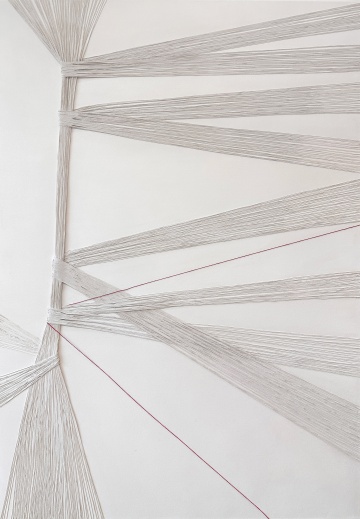
Sameh Khalatbari
1401 N/m² Resistance
May 18, 2023 - July 1, 2023
On September 16, 2022, a 22-year-old woman named Mahsa Amini was beaten to death in Tehran. Detained on the road and separated from her family, she was tortured and killed by the Gasht-e-Ershad, Iran’s morality police. Her crime? Improperly wearing the hijab, exposing her hair. Within hours, protesters had filled the streets of Tehran and many other cities.
Seven thousand miles away in San Jose, the Iranian-American painter Sameh Khalatbari watched the news on television. As a woman who’d been forced to cover her hair before emigrating to the United States, she felt intense distress. She nervously sketched as she stared at the TV. When she looked down at the iPad resting in her lap, she found that she’d drawn hundreds of lines.
“I felt a responsibility to be the voice of the people in Iran and to spread the word with my art,” she recalls. “But I couldn’t be direct. I still have family there. When I visit, I could be arrested.” Her art could not be figurative, as it had been in the past. “I thought of using the lines I’d drawn as a symbol of women’s hair.”
Modernism is pleased to present a selection of 12 works from the series Khalatbari created in response to Amini’s murder and the ongoing conditions of gender apartheid in Iran. Her first solo show at the gallery, 1401 "N/m² Resistance" takes its name from the year of the protests according to Iran’s Solar Hijri calendar and the metric unit of pressure. “'Resistance' alone could not express the magnitude of the event,” Khalatbari explains.
To embody her ideas and express the intensity of her feelings, she developed an entirely new technique. In the past, Khalatbari had always painted in acrylic on prepared canvases. For the new body of work, she worked with string, which she extended across canvas she stretched herself. “I wanted to make everything from scratch to show how this movement grew up from the heart of society, and how people naturally came to the street,” she says. “All of the fibers are natural, evoking women’s hair.”
Four of the works in the series are black, each bearing the name of a city where the protests were especially intense, suggesting the darkness of events. The remainder are white, which Khalatbari chose to show the calm perseverance of women in spite of their inner pain. A red thread runs through these works, symbolizing those who died in the protests. “Even with this loss of life, and even with the relentless pressure on their bodies, women stood in resistance,” she asserts. “They’re still standing and resisting.”
In aesthetic terms, Khalatbari’s abstract canvases evoke the artwork of Eva Hesse, deriving their strength from her mastery of raw materials and physical forces. This visceral effect is counterbalanced by Khalatbari’s commitment to symbolism in relation to color, connecting her work to Bauhaus masters such as Johannes Itten and Wassily Kandinsky.
Yet Khalatbari distinguishes herself from these aesthetic forebears because her art is also resolutely political. For many artists, abstraction and politics would be in tension. Khalatbari balances them as meticulously and elegantly as a mathematical equation.
Ilya and Kirill Zdanevich
From Futurism to 41º
May 18, 2023 - July 1, 2023
When Kirill Zdanevich [1892-1969] came of age as a painter, artistic movements were proliferating more rapidly than most artists could assimilate. From Impressionism to Fauvism to Cubism, every "ism" appealed to Zdanevich more than the formal training that he was receiving at the Imperial Academy of Fine Arts in St. Petersburg. By the time he competed his studies in 1913, traveled to Paris, and started to exhibit in Moscow, the young Georgian artist was fully committed to the avant-garde.
But Zdanevich, unlike other radicals of his generation, was not convinced that any movement had all the answers. As Russian avant-garde contemporaries such as Kazimir Malevich [1879-1935] made their case for the absolute truth of movements such as Suprematism, Zdanevich resisted by combining multiple movements in the same composition. He provocatively called it "Everythingism."
Kirill was not the only Zdanevich with maverick ideas. While he was advancing Everythingism, his brother Ilya [1894-1975] was developing a new approach to theater, comprising an orchestra of voices each performing in a different poetic style. In order to score these complex vocal arrangements – as aesthetically pluralistic as Kirill’s canvases – Ilya invented a dynamic new approach to typography.
Introducing an impressive array of artistic advances to their native Tiflis, and influencing the artistic avant-garde throughout the region, the brothers were close collaborators until the Russian Revolution overtook Georgia, Ilya emigrated to Paris, and the siblings were unwillingly separated by the Iron Curtain.
Modernism first introduced the Zdanevich brothers to San Francisco viewers in 1991, as Mikhail Gorbachev was introducing perestroika and glasnost to the Soviet Union. Thirty-two years later, as Russia invades Ukraine and recklessly revives Cold War divisions, Modernism presents a second exhibition of the Zdanevich brothers in less encouraging geopolitical circumstances. However, Kirill and Ilya’s artistic pluralism, which so perfectly matched the ‘90s spirit of glasnost, is arguably more vital now as an against-all-odds affirmation of cosmopolitanism.
Presenting eighteen works on paper by Kirill and three typographic works by Ilya, the current Modernism exhibition takes its name, "41°," from the collective that the brothers formed with several artistic contemporaries with sympathetic temperaments and beliefs. 41° stood for strong alcohol, high fever, and the latitude of Tiflis; their ambition, as articulated in the one and only issue of their newspaper, was nothing less than “to put the world on a new axis”.
Ilya pursued this ambition by liberating poetry from the burden of meaning. Sound was the essence of his performances, but his orchestral arrangements were also highly visual. Treating type as raw material for abstract composition, and sometimes counterbalancing lettering with collage, his layouts are simultaneously literary tours-de-force and graphic masterpieces.
Kirill’s drawings and paintings are also orchestral, orchestrating seamless arrangements of Impressionism, Cubism, Rayism, and even Suprematism. Orchestral painting represents “the purest artistic mastering,” Kirill proclaimed. The catalogue essay for his first major show in Tilfis elaborated: “By blending styles, the master frees art from the confines of temporary objectives.”
From the vantage of 2023, the truth of that statement is far more evident than it could possibly have been in 1917. Against the parochialism of the present moment, Kirill and Ilya Zdanevich offer an invigoratingly liberating vision.
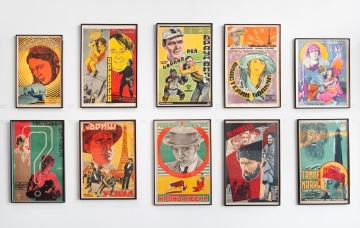
Mikhail O. Dlugach
Avant-Garde Film Posters of the 1920s
April 26, 2023 - July 1, 2023
Mikhail O. Dlugach [1893-1988] was a prolific Ukrainian poster artist and graphic designer. He was born in Kiev in 1893 and received his artistic training at the local art school where he studied from 1905 to 1917. In 1922 he moved to Moscow and started working as a film poster designer, soon becoming one of the leading artists in the field. In 1924 he joined the advertising department of the newly-established Reklam Film. The following year he produced his first film poster "Brigand Arsen." The trial proved successful and was rapidly followed by those for "Red Devil," "Kabiriya," and "At the Pillory."
In 1926 Dlugach joined AKhRR (The Association of the Artists of the Revolution), a union of artists who advocated realism in art. In his distinctive designs the figures of film actors were skillfully drawn and arranged on the poster plane into mises-en-scènes from the advertised films. In 1931 Dlugach also became a member of ORRP (The Association of Revolutionary Poster Artists). In 1940 he helped to design the exhibition pavilion at the All-Union Agricultural Exhibition in Moscow.
Dlugach continued to produce posters through the 1960s, executing over 500 during his career. His film posters of the 1920s and later established his place as a master of poster art. For this work he was officially recognized with the mounting of a major one-person retrospective in Moscow in 1985. Dlugach died in 1988 at the age of 95. His works are in the collections of major museums including the Museum of Modern Art, New York; the Tate, London; the Victoria & Albert Museum, London; and the Fine Arts Museums of San Francisco.
Naomie KREMER
Terra
March 16, 2023 - May 13, 2023
AN EXHIBITION OF PAINTINGS, HYBRID PAINTINGS, AND VIDEO
Many millennia before art was exhibited in galleries and illuminated with track lighting, paintings decorated the walls of caves where they were enlivened by the flickering of torch flames. The fugitive light animated the Ice Age depictions of animals while also rendering their forms ambiguous. Visitors could look at them forever and never see the same picture.
Naomie Kremer achieves an equivalent effect utilizing far newer media. Manipulating photographs of her paintings in video editing software, Kremer projects the moving images onto the canvases, accentuating the internal dynamics of compositions that hover between abstraction and figuration. “Uncertainty is more stimulating than certainty,” she says. “The state of uncertainty is dynamic.”
The dynamics of uncertainty are at the core of Terra, Kremer’s 18th solo exhibition at Modernism Inc. Created during the anxious years of the pandemic, as Kremer was in the midst of moving her studio, these paintings and hybrids manifest her reckoning with instability, and her recognition that the personal and planetary shakeup provided an opportunity for unprecedented creative development.
Although Kremer has been making digital hybrids for more than a decade, animating her paintings with disparate video footage, the pandemic provided her with the context to recognize that the paintings could animate themselves. “In the midst of the confinement of the pandemic I decided to give myself a wide-open space to explore,” she recalls. Isolated from worldly distractions, limited to making art and taking walks in the woods near her home, she became more focused while simultaneously letting her practice grow more expansive. The three hybrid paintings in the Modernism exhibit – two of them animating paintings she created years ago – bear witness to this dual transformation.
The chance discovery of several unused canvases led Kremer in another new direction. Kremer had been making drawings copying odalisques in Picasso’s erotic sketchbooks. Finding the primed surfaces of the canvases to be as smooth as paper, and the creamy color of the primer reminiscent of the sketchbook’s pages, she applied bold lines of black paint, allowing each stroke to determine what came next. “Every mark I make stays, and has to be incorporated into the next move,” she explains, comparing the process to the chain of events involved in creating a Surrealist Exquisite Corpse. Further accentuating the dynamic interplay of construction and decoupling, works such as Inklinks I are assembled as diptychs. “There are ways they connect and ways they don’t,” says Kremer. “Eros, flora, fauna, and saga come together in abstract, suggestive ‘stories’ that surprised me.”
A third new direction for Kremer also derived from moving to a new studio. Ruined old brushes provided her with novel ways of depositing paint on canvas. Soon she found herself exploring the imprints of brushes purchased from the hardware store: scrub brushes and kitchen brushes that she applied to the canvas like printing blocks. “I was trying to get away from the tyranny of the mark,” she says, describing a problem that has bedeviled masters from Henri Matisse to Jackson Pollock. “I love how those cheap brushes remove the need to make a decision about every stroke. It’s liberating, the way the marks make themselves. It provides a starting point for me to go in and negotiate between them with other colors and marks.”
On these canvases, patterns emerge from the concretion of chance events. For example, Teeming turned out to evoke a map of Earth from space. Sometimes, the patterns have more than one valence. Ring Cycle could be interpreted as a representation of tree rings or constellations.
For Kremer, this ambiguity captures a deep truth about reality. “From the galactic to the microscopic, there’s a visual relationship,” she says. “My work always has a fractal quality.” Like her digital hybrids and the cave paintings of Lascaux, Kremer’s works on canvas appear different each time they’re observed.
Shawn Huckins
If I'm Home, Find Me Here
January 12, 2023 - March 4, 2023
Our relationship with cloth is visceral and primal -- we are swaddled in it at birth and aside from a caregiver’s embrace, fabric is our first experience with touch and comfort. Who of us, in times of turmoil, has not pulled the covers over our head, or wrapped ourselves in a loved one’s shirt, sweater, or scarf? To be covered is to be comforted, protected, and hidden. To wit, cloak is both a garment and an action to shield from sight.
MODERNISM is pleased to present the fourth solo exhibition of contemporary American painter Shawn Huckins. The works in “If I’m Home, Find Me Here” employ modern fabrics painted over traditional American portraiture to explore questions surrounding what, how much, and how well we share and hide.
In these hand-painted recreations of historic works, fabrics are staged on a model in the studio, lit from the same direction and with the same temperature as the light source in the original painting, then drawn into the final composition. Bold, bright, and colorful fabrics cover all, or significant portions of the portrait. Viewers get few clues about the sitters, save an exposed hand, piece of jewelry, or beloved pet, all superficial details chosen to be revealed. Only in a painting’s title do we learn the subject’s identity, anything more that might be known about these people remains hidden beneath piles of cloth and clothing so ubiquitous it could be our own.
Regarding concealment, Huckins says, “We use cloth to conceal, but also to express, selectively, based on how we see ourselves and how we want others to see us. Of course, we don’t express all facets of our identity, some things we hold near out of habit, nature, or fear of ridicule.” "If I’m Home, Find Me Here" gives us the opportunity to question the security of our own concealments. What are we concealing from ourselves and others? What would it mean for the parts we conceal to be exposed? How would others react to our dirty laundry?
Portraits of unnamed noblewomen, originally portrayed by painters like Jean-Marc Nattier (1685-1766) and Godfrey Kneller (1646-1723), see the addition of towering fabric obscuring the sitters’ faces. Paintings such as "Pride Portrait II (after Mengs)" shroud the subject while simultaneously supplying information about them. Draping the subject’s face with a Pride flag, rainbow cloth, and various garments suggests identifying characteristics for the unidentified sitter. This leaves us wondering what is hidden and what might be revealed should the fabrics fall, but also probes on how our perception of these subjects might change once uncovered and which subjects we’d prefer to be.
On the origin of this body of work, Huckins shares, “Like most people, the global pandemic made me re- think my life goals and what I truly value. I was at a point in my career where I needed to be re-energized by painting again. During the first COVID lockdowns, we couldn’t leave the house and most businesses were closed. To pass the time, I started painting the patterns of my wardrobe, which consists of bold, plaid patterns, to create small, abstract paintings. This exercise was the complete opposite of what I was painting at the time and I found it to be fun, yet challenging. I wanted to combine these experimental paintings with my usual portraits, so I started combining the contemporary fabrics over top historical paintings.”
Though the introduction of contemporary fabric is a new direction for artist Shawn Huckins, obscurity of the subject is not a new practice. Selective presentation of the subject was previously utilized in the series of work presented at Huckins’ second MODERNISM exhibition "Fool’s Gold" (2018), where the subjects of historical paintings are obscured by the addition of Adobe Photoshop’s erasure indicator, a grey-and-white checkerboard pattern. While "Fool’s Gold" draws attention to the obscurity of our nation’s history, "If I’m Home Find Me Here" speaks to concealment of the individual’s identity, making this series Huckins’ most intimate yet.
SHAWN HUCKINS (born 1984, Laconia New Hampshire) currently resides in the bucolic Monadnock region of southwestern New Hampshire. His work has been exhibited internationally and is displayed in collections of The Museum of Fine Arts in Boston, MA, The Tucson Museum of Art, The TIA Collection, and The Vicki Myhren Gallery at The University of Denver.
Agnieszka PILAT
ROBOTa
November 4, 2022 - November 22, 2022
As a dedicated young draughtsman with an interest in painting, Leonardo da Vinci was taken by his father to a Florentine master named Andrea del Verrocchio. Impressed by the young man’s talent, Andrea apprenticed him, providing Leonardo with training in skills underlying the masterpieces for which he’s now famous. Leonardo also had a hand in Andrea’s own paintings, contributing to altarpieces and private commissions.
Recognizing the value of apprenticeship for artists of promise, the painter Agnieszka Pilat recently offered apprenticeships to Digit and Spot. Unlike Leonardo, Digit and Spot are robots. Products of Boston Dynamics, they’re widely admired for their mechanical dexterity. But it took Pilat – who was schooled in the European tradition of figurative painting – to appreciate their latent creative potential.
MODERNISM is pleased to present the results of this unprecedented year-long apprenticeship: a dozen large-scale oil paintings that offer visual delight while expanding upon the conceptual groundwork of Marcel Duchamp and Jean Tinguely by questioning conventional ideas about creativity, authorship, and even human nature. “Working in close contact with a robot gives the impression of an encounter with another mind,” says Pilat. “It seems that the robot has agency.”
Each of the two robots shows a distinctive artistic personality. With a humanoid form and movements that must be programmed in advance, Digit manipulates brushes with an energetic angularity reminiscent of Jean-Michel Basquiat, as can be witnessed in a video on view at Modernism. Shaped like a dog, Spot holds paint sticks in his mouth while making controlled motions under Pilat’s direct guidance. As can be seen on the gallery walls, the paintings have calligraphic qualities evocative of Cy Twombly. Spot has also specialized in making multi-colored circles of spattered paint tracked with his feet, several of which are on view at the MODERNISM show. The circles are geometrically perfect yet spontaneous in their color patterns, a sort of hybrid of Hard-Edge Abstraction and Abstract Expressionism.
Pilat was first acquainted with Spot and another Boston Dynamics robot named Atlas when they modeled for her several years ago, reenacting some of the most important works in art history for her previous MODERNISM exhibit. But this new body of work provides a manifestly different perspective, one that comes from within.
“All of my apprentices’ gestures are inspired by their motor control, and also reveal their mechanical limitations,” observes Pilat. “Both Digit and Spot are imperfect extensions of my arms. When they transfer my aesthetic ideas onto canvas, those ideas are translated into the physical language of machines.”
Pilat finds the awkwardness of the translation to be edifying. “Through flawed execution, my mastery of painterly tradition is reinvigorated,” she says, expressing concern about the decorative superficiality she sees in most contemporary painting. “I am the robots’ master, and also their apprentice.”
In the spirit of apprenticeship, Pilat is careful not to take all of the credit. “Imperfections make robot art strangely original,” she observes. The reality of robotics is far less impressive than the hype – no risk of Spot overshadowing her as Leonardo did Andrea del Verrocchio – and this paradoxically this makes them more impressive.
“The threat to human artists and their exhausted abstract gesticulations is to be found in the machines’ mistakes,” Pilat asserts. “Through their errors, robots promise to make art interesting again – interesting for people and perhaps one day for their fellow machines.”
Henri Matisse
Nudes and Odalisques
September 8, 2022 - September 29, 2022
In 1903, two years before his emergence as the leader of Fauvism, Henri Matisse made a modest self-portrait depicting himself as an etcher. Based on this small black-and-white print, one might never have imagined Matisse becoming the most radical colorist of his generation. Yet the etching foreshadowed another dimension of his illustrious career, less widely appreciated but equally original. Over the following five decades, working sporadically at the etching plate and lithograph stone, Matisse produced an oeuvre of more than a thousand extraordinary prints and plates for "livres d’artiste".
MODERNISM is pleased to present a museum-quality selection of thirty-one prints produced by Matisse between 1913 and 1947, focusing on his nude and draped representations of women in the 1920s, a period during which he almost single-handedly made lithography modern. Printed by the artist in small editions usually not exceeding fifty examples, these works on paper display Matisse’s genius for line and composition in their purest form—dazzling the eyes with nothing more than black ink on white paper—while simultaneously reaffirming MODERNISM’s commitment to major exhibitions of work by modern masters including Edvard Munch, Kazimir Malevich, Pablo Picasso, Alexandra Exter, Alexander Bogomazov, Le Corbusier among others.
For all his acclaim as a colorist, Matisse considered the line to be fundamental to his art, working toward his great canvases by drawing from life. Printmaking provided him with a medium in which the directness and intimacy of those drawings could be transformed into finished works as autonomous as the great paintings. His prints proved also to be an ideal space for formal experimentation, and the perfection of the aesthetic qualities he most valued. With no margin for error, plate and stone challenged the artist to live up to the standard he articulated in "Notes of a Painter": “The entire arrangement of my picture is expressive: the place occupied by the figures, the empty spaces around them, the proportions, everything has its share.”
Works in “Nudes and Odalisques” range from the deceptively simple to the spectacularly complex. The former category includes etchings of almost impossibly few lines, verging on abstraction, such as "Jeune fille rêvant près d'un bocal de poissons" (1929), showing a young woman gazing past a bowl of fish. The latter category includes lithographs of such subtle shading that the subjects emerge from the page, such as "Le renard blanc" (1929), depicting a young woman cloaked in a luxurious white fox coat.
Matisse’s passion for the exotic is well represented in voluptuous odalisques such as "La jeune hindoue" (1929). The eroticism is no less intense in the spare "Nu couché sur sol fleuri" (1929), a work that also illustrates Matisse’s ability to take a figure such as the arabesque as a graphic element unifying the curves of the female body, the contours of bourgeois French furniture, and the patterns of period textiles, all brought to life by the subtlest variations in the ways his stylus touches the drawing surface.
“One must always search for the desire of the line,” Matisse told the great collector Sarah Stein in 1908. The lithographs and etchings in “Nudes and Odalisques” deliver the bounty of his search – and are bound to stir up desire in connoisseurs and collectors today.
ARTWORK:"Odalisque à la coupe de fruits", 1925 Lithograph on Chine paper, Edition of 50
Kristine Mays
Threads of Existence
July 7, 2022 - September 1, 2022
When Kristine Mays first saw Revelations, Alvin Ailey’s iconic modern ballet, she was moved by the bodies in motion, and Ailey’s transposition to the stage of his experiences growing up as an African-American in segregated Texas. Ailey’s masterpiece gave choreographic expression to physical labor on plantations and the spiritual work of the Baptist church. As a contemporary African-American sculptor, Mays was inspired to attempt an even more radical transformation, capturing these kinds of physical and spiritual movement in thousands of interconnected strands of wire.
Mays has developed her unique sculptural method over more than a decade. Initially exploring the sculptural qualities of beading wire she encountered as a jeweler, she has transitioned to monumental figures, each handmade by bending and hooking rebar ties with pliers. Each piece takes at least sixty hours of labor during which she gives form to a human body or garment without reliance on a mold or model. Especially remarkable are the gestural qualities that make the works appear both animate and soulful. “I am breathing life into wire,” she says. “With each work, I create a form that reveals the essence of a person and that speaks to humanity as a whole.”
Modernism is pleased to present a dozen of Mays’ large-scale wire sculptures in Threads of Existence, her first one-person exhibition with the gallery. All of the works reference African-American heritage or her own lived experience as a Black woman born and raised in San Francisco. They can be appreciated in purely formal terms in the figurative tradition of Antony Gormley, and their technical virtuosity is in the same league as the wire sculptures of Ruth Asawa. However, Mays’ work can also be fiercely political, an eloquent artistic expression of feminism akin to Anselm Kiefer’s powerful new Femmes Martyres sculpture series, and an equally powerful sculptural statement of anti-racism.
Quotations accompanying her sculptures often provide important context for full appreciation of their content. For instance, Mays confronts body image in several sculptures of dresses, which source lines from poets such as Nayyirah Waheed and Ruby Dee. (The latter is contextualized with Dee’s dictum that “The kind of beauty I want most is the hard-to-get kind that comes from within - strength, courage, dignity.”)
Mays also confronts the history of slavery, and the ongoing oppression of Blacks in the United States, with a sculpture depicting a pair of overalls like those worn by laborers on plantations. Titled Buck, the work speaks to the treatment of African-American men by whites in the past and present. “The Black Buck is not viewed as a man but rather a thing,” she says, referencing victims of bigotry ranging from Emmitt Till to Ahmaud Arbery. “And when his strength, his compassion, his tolerance, his love and understanding is revealed, that is when he is the most vulnerable in a world that wants to deny that he is human.”
Exhibited in venues ranging from the California African American Museum to the Atlanta Botanical Gardens, Mays’ art puts humanity front and center by compelling viewers to see the people within the loops of wire. “The beauty of working with wire is that it’s been used in the foundations of buildings,” she says. “I know it has that durability to last.” Timely and topical today, her work is made to reverberate through the ages.
Raymond Holbert
Aquatic Opera
July 7, 2022 - September 1, 2022
Raymond Holbert’s studio is a swimming pool. Measuring thirty square feet, and twelve feet deep, his underwater set is an otherworldly space where models can express themselves with angelic grace. A versatile artist who has worked in media ranging from pen-and-ink to color photography over five productive decades – and exhibited in venues ranging from the Museum of African American Life and Culture to the Philadelphia Museum of Art – Holbert approaches this studio not only as a realm where physical movement is unconstrained but also where the imagination has free reign. The creative act is a collaborative performance by the models and artist. Holbert calls it an "Aquatic Opera".
Modernism Gallery is pleased to exhibit fourteen tableaux from this magnum opus. Taking the form of photographic murals, they each present imagery of bodies in motion that Holbert captured underwater at different times of day, combined with drawings and photographs he has made in his more conventional Berkeley studio and on the streets of the East Bay.
These seamless digital collages invite the spectator into the performative space where the dancers await in a state of suspended animation. Some of the men and women wear spectacular costumes, a reminder of Holbert’s decades of experience in fashion photography. The audience’s experience is further enhanced by Holbert’s evocative titles, often laced with operatic references such as aria and adagio, bringing music to mind and transforming each tableau into a Gesamtkunstwerk.
Holbert’s entry into this unusual milieu was inspired by his own passion for swimming, and his recognition of the potential of underwater motion from personal experience. “There are movements that can be realized in the water that cannot be done without it,” he says. “The breadth of omni-directional movement is an ability that works for every relaxed swimmer without much regard to capabilities.”
The result is a fresh contribution to artistic engagement with swimming seen in the work of masters such as David Hockney. Yet it is equally notable for the numinous quality of a space unconstrained by gravity, a contemporary perspective on the heavenly tableaux of Tiepolo, and a complement to Kehinde Wiley's overhead stained-glass paintings of break dancers at Penn Station.
Jacques VILLEGLÉ
Jacques VILLEGLÉ and the Streets of Paris
May 19, 2022 - July 1, 2022
Modernism is pleased to present its eighth in-depth survey of décollage works by Jacques VILLEGLÉ, one of France’s most influential contemporary artists.
This exhibition also marks the release of our major new monograph: “Jacques Villeglé and the Streets of Paris” by Barnaby Conrad III, the first comprehensive book on Jacques Villeglé in English.
For over seventy years, Jacques VILLEGLÉ’s work has played an important role in redefining what constitutes a work of art. He is an artist who was instrumental in bringing the streetscape into the space of the exhibition.
Jacques Villeglé spent most of his life wandering the streets of Paris, pulling torn advertising posters off the ancient walls and pronouncing them Art. “In seizing a poster, I seize history,” he says. “What I gather is the reflection of an era.”
Born in Brittany in 1926, Villeglé was a seventeen-year-old architectural apprentice in Nantes during the bleak days of the German Occupation. After the Liberation in 1944, he moved to the City of Light, where he was drawn to filmmaking, avant-garde Lettrist poetry, and painting. The prewar art movements of Cubism and Surrealism had melted into abstraction, but Villeglé’s earnest attempts at Art Informel soon struck him as redundant, and he destroyed his canvases. Without a job and at loose ends intellectually, he became a flâneur, a curious intellectual roaming through war-scarred Paris. “As I walked through the streets, I was struck by the color and typography of the posters. In those days, the cinema and concert posters rarely had images—just words—and they had been torn and shredded to where they became something else, with a post-cubist look to them. I began to see them as paintings made by anonymous hands.”
In 1949, Villeglé and his then artistic collaborator, Raymond Hains (1926–2005), scavenged advertising from billboards on the grand boulevards, snatched political posters in the financial district, and pillaged Left Bank walls plastered with flyers for jazz concerts and art exhibitions. Mounting them on canvas, they presented a new kind of art. Between 1949 and 2003, Villeglé himself plucked more than 4,500 works from all twenty of Paris’s arrondissements, carefully labeling each with the exact date and street address of the heist, just as a lepidopterist might record the habitat of a newly captured butterfly. Each work became a unique time capsule of the ever-changing city.
Jacques VILLEGLÉ’s work has been exhibited extensively in the United States and Europe, and is the collections of many important museums worldwide (Museum of Modern Art, New York; Museum of Contemporary Art, Los Angeles; Detroit Institute of Arts; Centre Georges Pompidou, Paris; Tate Gallery, London; Moderna Museet, Stockholm; Musée d’Israël, Jerusalem). In the fall of 2008 a major retrospective of his works was exhibited at the Centre Georges Pompidou, Paris. In 2011 Modernism published the English translation of Villeglé’s theoretical writings Urbi et Orbi from 1959.
Edith BAUMANN
New Works
March 24, 2022 - May 14, 2022
Rev. Dr. Richard Davey, Research Fellow in the School of Art and Design at Nottingham Trent University, UK, described Edith Baumann’s paintings as inhaling, then exhaling. “In a fluid gesture, she leaves a breath of paint on the picture surface.”
Building on her four decades-long practice of creating geometric abstract paintings, in the current two new bodies of work in the present exhibition, Baumann has integrated a new element, overlapping her usual solid grounds and rectangular shapes, of thinly brushed on layers of paint, which reveal and conceal the colors they overlap, but also display the artist’s hand in a way not seen in her prior work.
The rich, strong colors are achieved by Baumann grinding raw pigments to make her own paints. The emerging colors inform the relationship between the solid geometric forms and gestural marks. They do seem to breathe.
Beyond historical abstraction, which connoted purity and ascetic withdrawal from the world, Baumann’s paintings are characterized neither by a monkish self-referentiality, nor by unmediated self-expression. While they are personal, they are not autobiographical. Her anti-egotistical position recalls that of California artist John McLaughlin (1898-1976), who appreciated “the economy of means” in oriental paintings. “These paintings,” McLaughlin wrote, “I could get into and made me wonder who I was. By contrast, Western painters tried to tell me who they were.” Like McLaughlin, Baumann paints as much for the spectator as for herself.
Modernism is pleased to present its third one-person exhibition of paintings by Edith Baumann.
Baumann’s work has been exhibited in galleries and museums internationally. She lives and works in Santa Monica, California.
Group exhibition
Autour de l'insolite
January 20, 2022 - March 5, 2022
When the pioneering Japanese roboticist Masahiro Mori considered the future of his field in 1970, he anticipated a phenomenon that he found troubling. As automata became more lifelike, more closely resembling humans, Mori predicted that they’d enter an “uncanny valley,” a realm where they were disarmingly bizarre. Mori’s prediction has come to pass in technologies ranging from Disney animatronics to metaverse avatars. However, the great German artist Hans Bellmer anticipated Mori by nearly half a century, deliberately using the uncanny for artistic effect.
Bellmer’s celebrated Poupée series of the 1930s featured an articulated pubescent female doll he photographed in sexual poses that appeared almost but not quite human: a fetish object that elicited equal parts desire and unease. One of these important Surrealist artworks is a highlight of a new museum-quality exhibition opening today at Modernism Gallery. Autour de l’Insolite II explores the surprising and bizarre – l’insolite in French – in over 50 works of modern and contemporary art. Encompassing painting, sculpture, drawing, and photography, and featuring artists ranging from Francis Picabia to Hannah Hoch to Tony Oursler to Peter Shire to R. Crumb to Jean-Charles Blais, the exhibition is the second chapter in the gallery’s comprehensive investigation of l’insolite. (The first chapter was exhibited in 1999).
Although the uncanny is an important aspect of l’insolite – and thoroughly represented in works by artists including Romi, Carmen Calvo, and Gottfried Helnwein – the exhibition also covers myriad other facets of the surprising and the bizarre. Some works playfully capture how life can be stranger than fiction, such as a spectacular hand-colored 1904 photograph by Underwood & Underwood documenting a couple in a “horseless” carriage pulled by a large ostrich. Other works enter domains beyond human experience, such as the Horsehead Nebula Cloud, as photographed by the astronomer David Malin in 1975.
Numerous paintings and drawings drop the viewer into inexplicable situations. Twin girls listen attentively to a bowl of goldfish in an arresting double self-portrait by Elina Anatole. In a charcoal by David Bailin, a middle-aged man surveys an empty landscape from a ladder in his fenced garden. Darkroom magic and photocollage offer other forms of disorientation – including conflicting perspectives and extreme juxtapositions – exemplified by important works by Andre de Dienes, Dora Maar, and André Racz.
Artistic visions of the exotic, real or imagined, provide another important theme in the exhibition. The German dancer Alexander von Swaine performs a costumed Javanese dance in a 1920s photograph by Otto Kurt Vogelsang. And in Les Paradis Perdus, the photographer Thierry Vasseur offers his own postmodern version of Eve’s temptation by posing a woman in lingerie wrangling a serpentine twist of metallic ventilation pipe. (John Milton would certainly have been surprised.)
Where l’insolite is not directly shown, it’s evoked through figures in various states of reverie or trance. We experience the strangeness of this space vicariously through the diaphanous human figures in the 1930s photography of Edward S. Curtis and a 2003 painting by Grisha Bruskin.
Although “surprising” and “bizarre” are standard translations for l’insolite, the concept is really too complex to be contained by terminology, English or French. As the surprising and bizarre work in this exhibition shows, l’insolite truly comes into focus only in art.
Exhibiting artists:
African tribal art
Laure ALBIN GUILLOT [1879-1962]
Manuel ÁLVAREZ BRAVO [1902-2002]
Elina ANATOLE
Anonymous
David BAILIN
Nono BANDERA
Glen BAXTER
Hans BELLMER [1902-1975]
Wallace BERMAN [1926-1976]
Jean-Charles BLAIS
Douglas BOND
Deborah BROWN
Grisha BRUSKIN
Carmen CALVO
Bruce CONNER [1933-2008]
Le Boucher CORPAATO
R. CRUMB
Edward CURTIS [1868-1952]
Andre DE DIENES [1913-1985]
Germain DOUAZE
Philip GARNER
John HAVINDEN [1908-1987]
Gottfried HELNWEIN
Hannah HÖCH [1889-1978]
Shawn HUCKINS
James JIN
Michael KVIUM
Vladimir LEBEDEV [1891-1967]
Dora MAAR [1907-1997]
David MALIN
Sandra MARTAGEX
McDERMOTT & McGOUGH
Pierre MOLINIER & Clovis TROUILLE [1900-1976 & 1889-1975]
Tony OURSLER
Robin PALANKER
Philadelphia Wireman
Francis PICABIA [1879-1953]
André RACZ [1916-194]
ROMI [1905-1995]
Manuel RUFO
Peter SHIRE
Robert STIVERS
Mark STOCK [1951-2014]
Hiroshi SUGIMOTO
Roland TOPOR [1938-1997]
UNDERWOOD & UNDERWOOD [1859-1947 & 1862-1943]
Thierry VASSEUR
Otto Kurt VOGELSANG
image:
Laure Albin GUILLOT [1879-1962]
"La Demone," c. 1928
gelatin silver print
15 3/4 x 11 3/4 inches
Agnieszka PILAT
Thinking Machines: Renaissance 2.0
September 23, 2021 - October 31, 2021
When Agnieszka Pilat first met Spot, she was astonished by the robotic dog’s ability to climb a staircase with lifelike agility. As a painter with a deep interest in innovation, Pilat was reminded of one of the 20th century’s most innovative paintings, Nude Descending a Staircase (No. 2), by Marcel Duchamp. In his 1912 canvas, Duchamp depicted the movement of a nude woman as a series of superimposed frames, much as a machine might perceive and analyze human motion. As an artist-in-residence at Boston Dynamics – the manufacturer of Spot – Pilat was inspired to portray the innovative bio-inspired machine as Duchamp might have done.
Over the past decade, Pilat has deployed her classical training to work at the intersection of technological progress and artisanal tradition. The twelve canvases featured in her first exhibition at Modernism Gallery are meticulously executed in oil on linen, taking inspiration from Leonardo da Vinci and Michelangelo, as well as Marcel Duchamp. But her art is no mere copy of the masters. She has not only replaced their human subjects with robots, but also ingeniously portrayed these new entities in a gestural language evocative of robotics.
“I’m interested in questions of authorship,” she says. “Authorship has traditionally been associated with the hand of the artist. What happens to authorship in a time when machines are capable of endless repetition?”
To explore these issues, Pilat has sought to embody the cutting-edge technology she witnessed at Boston Dynamics by making multiple copies of the same image. For instance, she has painted her version of Nude Descending a Staircase twice. The paintings are in different color palettes, both evocative of the Pop art of Andy Warhol, who famously said “I’d like to be a machine”. However, the difference in colors is only the most obvious contrast evident in her two paintings. Unlike Warhol, who used mechanical techniques such as silkscreening in his best-known pieces, Pilat has worked by hand, resulting in expressive discrepancies in every detail. Her efforts to paint like a robot paradoxically betray her humanity.
For Pilat, this does not amount to triumph or defeat. As she observes, “Machines are humanity’s children.” In this familial relationship, neither is inherently superior – let alone an existential threat to the other – though she acknowledges that “machines are today’s celebrities, perhaps even the aristocracy of the 21st century”. By painting their portraits, she carries on a tradition stretching from Renaissance studios to Warhol’s Factory of the 1960s.
The majority of work in her Modernism exhibition focuses on the Renaissance, with images derived from Leonardo’s Vitruvian Man and Michelangelo’s Sistine Chapel fresco. Pilat sees an important connection between the Renaissance and the present moment, especially evident to her as an artist based in Silicon Valley. “Much as innovation changed the world during the Renaissance, innovators in the Bay Area and the Boston region are changing the world today,” she says. In tribute to this history, and referencing the language of software iteration, she has dubbed her new series Renaissance 2.0.
image:
"Vitruvian Man in Cool Blue," 2021
oil on Belgian linen, augmented reality
78 x 78 inches
Charles Arnoldi
Natural Selection
September 9, 2021 - October 23, 2021
While visiting Machu Picchu in 2017, Charles Arnoldi was struck by the perfect fit of the rocks from which the ancient city walls were built. The architectural stability of the irregularly-shaped slabs of granite suggested a compositional approach to balancing blocks of color. When he returned to his studio in Southern California, Arnoldi set to work on a new series of paintings inspired by the Inca archaeology.
As is usually the case for Arnoldi, the series inspired several others, intermingling visions of masonry with visual inspiration from sources ranging from viruses to his own prior painting. “I guess I’m just an intuitive guy,” he says with characteristic candor and modesty.
An important and acclaimed California abstract painter and sculptor, Arnoldi has been channeling visual intuitions into transcendent large-scale artworks since the late 1960s, when he moved from the Midwest to Southern California and became the youngest member of the Venice Beach scene. Arnoldi’s extraordinarily versatile virtuosity is in full view in his 10th one-person exhibition at Modernism, which includes twenty paintings, sculptures, and works on paper competed over the past five years.
The exhibition highlights Arnoldi’s lyrical application of color, which enlivens organic abstractions comprising tangles of line, geometric tiling, and the irregular blocks inspired by Machu Picchu. The architectural blocks are also evoked in wooden sculptures hewn with a chainsaw, repurposing an unconventional studio technique that Arnoldi has applied intermittently to paintings on plywood since the early ‘80s.
The aesthetic variety is a natural outcome of Arnoldi’s commitment to process, and his eagerness to experiment, traits he holds in common with Venice Beach scene peers including Joe Goode and Billy Al Bengston. “I let the paintings develop themselves quickly and spontaneously,” he explains. “I'm not trying to make a signature style of art, not an Arnoldi. I am just trying to make paintings.”
However, all of Arnoldi’s compositions are unified by his conviction that each work must be autonomous. “In abstract painting, an artist invents a problem and solves it,” he says. Like the Inca architects of Machu Picchu, who found balance in asymmetry.
Arnoldi's work resides in numerous major public and private collections and museums internationally, including the Museum of Modern Art, the Metropolitan Museum of Art, The Los Angeles County Museum of Art, the Smithsonian American Art Museum, and the Guggenheim, Bilbao, Spain.
LA ABSTRACTION: 1980-2000
July 15, 2021 - September 4, 2021
In the late 1950s, when New York was the capital of the art world, Los Angeles was a leader in several industries that would improbably help LA to rival Manhattan in artistic importance. One was the movie business. Another was aerospace. Equally significant, LA was a place where many people lived without industry or artistic pretensions, thriving instead on sun and surf, sometimes augmented with spiritual practices and psychedelics.
Over several decades, these personal and professional factors would coalesce in ways that overcame the predominance of Abstract Expressionism and offered meaningful alternatives to Minimalism and other East Coast advances in abstraction. Hard-edge painting was pushed to a "fetish finish" perfection. Light and Space Art transformed museums into immersive environments. In myriad ways, Los Angeles artists combined cinematic effects with high-tech materials to create works surfacing their deep interest in perception, influenced by factors ranging from Zen Buddhism to the natural beauty surrounding them. These advances reached full maturity in the final decades of the 20th century.
Modernism Inc. has exhibited key Los Angeles abstractionists since the gallery’s founding in 1979, representing renowned painters including Charles Arnoldi, Edith Baumann, James Hayward, Peter Lodato, David Trowbridge, and John M. Miller. Building on this history, as well as the gallery's notable 1993 restaging of Four Abstract Classicists—a landmark 1959 Los Angeles County Museum exhibition that introduced the world to the creative ferment in Los Angeles—Modernism is pleased to present LA Abstraction: 1980-2000, a sweeping survey of fourteen major abstractionists who collectively reveal the diversity of abstractions that flourished some 2,500 miles from Manhattan.
Los Angeles artists paid close attention to visual perception from the beginning. In the early ‘60s, Larry Bell began to experiment with glass, fascinated by the ways in which it both reflected and absorbed light, defying its own materiality when coated with thin films of metal. Several years later, James Turrell discovered that he could make art with pure light passing through holes in his studio walls. Atmospheric effects were also explored by Mary Corse and Lita Albuquerque in painting and sculptural objects. Over the following decades, Light and Space Art would overtake entire galleries and spill out into the open, especially when Turrell and Albuquerque adapted optical effects to the tradition of Land Art. Simultaneously all of these artists worked in two dimensions, imbuing the traditional picture plane with unfathomable depth, as can be seen in numerous works on view at Modernism.
Related to Light and Space, and sometimes overlapping with it, was a fixation on formal abstraction, sometimes hard-edge or imbued with a fetish finish. The Modernism exhibition includes many fine examples. In the case of artists such as Scot Heywood, John M. Miller, Edith Baumann, Peter Lodato, and Alan Wayne, geometric compositions hold the eye in suspense through juxtaposition of colors and shapes that are always exacting and often surprising. James Hayward’s canvases show equal attention to perceptual nuance, achieved through the application of countless layers of oil paint, often of different hues, to create works that appear monochromatic and that seem to radiate captured light. Tony DeLap and David Trowbridge have both pushed formal abstraction into three dimensions, finishing materials such as wood to the same rigorous standards as their painted surfaces, breaching the divide between perception and reality.
The relentless experimentation present in all of this work is central to the work of Charles Arnoldi and Ed Moses, whose paintings round out the Modernism show. Over six decades, Arnoldi has found abstraction in the
natural lines of gathered twigs, has assembled abstract compositions by segmenting painted plywood with a chainsaw, and has challenged distinctions between painting and drawing in acrylic abstractions that energetically press organic flourishes against hard-edge geometry. Moses was no less inventive over seven productive decades. An original member of the pioneering Los Angeles artists known as the Cool School (along with Larry Bell), Moses referred to himself as a “mutator” whose art was unified only by a commitment to mark-making in the service of perceptual discovery.
The vast range of Moses’s work is a sort of synecdoche for LA abstraction more broadly. Whether hard- edge or organic or rendered in thin coatings of metal, the works in LA Abstraction all awaken the viewer to the boundlessness of what the eye can see.
Gottfried Helnwein
Eyes That Knew No Shade of Sin or Fear
May 6, 2021 - July 2, 2021
Nearly two centuries after the great Spanish artist Francesco Goya made the series of prints known as The Disasters of War, eternally preserving the atrocities he witnessed during six years of conflict between Spain and France, Gottfried Helnwein set out to create a new version. Beginning in 2008, Helnwein sought to show that cruelty is not history, and also to shift the focus from battlefield hardships to the inner life of children. “I want to see what’s going on through the child’s eyes,” he says. With that psychological shift came an important permutation in meaning, from graphic accusations of crimes against humanity to metaphors “for the potential of innocence.”
Helnwein is still painting Disasters, surpassing the ten-year span that Goya worked on his print sequence. The seventy-ninth painting, completed earlier this year, is featured in Eyes That Knew No Shade Of Sin Or Fear, a major new exhibition of Helnwein’s magisterial art, which will go on view at Modernism gallery next month. Depicting a young girl holding an Uzi, looking away from a grinning Mickey Mouse, The Disasters of War 79 powerfully conveys the urge children feel to fortify themselves against the atrocities pervading modern society, and their struggle to remain true to their guileless fantasies.
These psychological tensions, and the insights they provide about the fraught conditions of the contemporary world, reverberate throughout the exhibition of thirteen paintings, all completed in 2021. Although they vary considerably in their iconography – evoking artists ranging from John Everett Millais to Edward Hopper – the artworks are unified by the moral impulse Helnwein identifies with Goya, which he describes as the compulsion to “force people to look at things they would rather not look at.”
Several paintings in the exhibition are structured around Disney characters. In addition to Mickey Mouse, Donald Duck is an important figure, connecting Helnwein’s artwork to some of the first art that made an impression on him: the drawings in comic books he found as a child in post-War Vienna, left behind by American soldiers, which gave him hope in a land of despair. “It was like opening the doors of heaven,” he recalls. The cognitive disconnect he felt between Disney’s thrilling playspace and the cold reality of an Austrian society in a state of depravation and collective denial is one that allows Helnwein still to empathize with children’s troubles, and to present the world from their point of view.
This sensibility can also be found in works that place cartoon-inspired figures in hyper-realistic urban hellscapes, such as All That We See or Seem is But a Dream Within a Dream. Portraying a wide-eyed female manga character in front of a car on fire in a collision of imagery rivaling James Rosenquist’s Pop Art juxtapositions, the painting suggests that our world has become ferociously hostile to the imagination, burning out the last respite of childhood innocence.
All That We See or Seem is But a Dream Within a Dream takes its title from a poem by Edgar Allen Poe, a major influence on Helnwein, alongside Goya and Disney. In the 1849 poem, Poe describes the sensation of passing time, comparing it to grains of golden sand seeping through his fingers more quickly as he tries to grasp them more tightly.
While Poe’s poem speaks to the grown-up sensation of aging, and its apparent acceleration over the course of a lifetime, Helnwein’s paintings evoke the accelerating advance of grown-up problems on the first years of life. Two centuries after Goya completed his Disasters of War, Helnwein shows that the atrocity not only persists, but also that the cruelty is threatening all possibility of innocence in those who will follow us.
Most recently the subject of a major retrospective at the Albertina Museum in Vienna, and compared to the work of old and modern masters including Franz Xaver Messerschmidt and Francis Bacon, Helnwein’s work has been exhibited extensively worldwide, and is featured in the collections of major museums in Europe, Asia and the United States. All That We See or Seem is But a Dream Within a Dream is his 18th one-person exhibition at Modernism gallery.
image: "Midnight in the Garden of Good and Evil,” 2021, oil & acrylic on canvas
Glen Baxter
Beyond the Basalt Obelisk
March 9, 2021 - April 24, 2021
Attending the Leeds College of Art in the early 1960s, Glen Baxter found himself surrounded by students who cared only for abstraction and sought to paint like Mark Rothko or Willem de Kooning. As a lifelong fan of the Marx Brothers, Baxter was skeptical of their bombastic posturing, and all the more so when instructors chastised him for his irreverent figurative drawings. Taking his cue from his hero Harpo Marx, and also countercultural figures such as Alfred Jarry and André Breton, Baxter rebelled against the seriousness of the artworld by making art that was seriously unserious.
Over nearly six decades, Baxter has created an absurdist alternate reality, depicted in masterfully deadpan line drawings, often captioned and sometimes hand-colored. Modernism Gallery is pleased to present nineteen recent dispatches—several reflecting life under quarantine—in Beyond the Basalt Obelisk.
Baxter’s unique oeuvre evolved from his deep appreciation of Surrealism. Early in his career, he was especially inspired by the 1930s collages of Max Ernst. Ernst’s expert appropriation of Victorian engravings – and his subversion of their self-conscious propriety through nonsensical reshuffling – provided Baxter with a compelling alternative to the self-seriousnessof Abstract Expressionism. He made the art of juxtaposition his own by appropriating the British adventure books of his youth. Their overwrought style, and language far too sophisticated for the young audience they were intended to entertain, translated naturally into a visual idiom that Baxter enlisted to upend the society he lived in utilizing the leverage of humor.
“The foundation of Baxter’s work is the intentional embrace of qualities that made these adventure stories ludicrous,” writes the art critic Jonathon Keats in an essay for the catalogue published to coincide with Baxter’s Modernism exhibition. His pictures and words are slightly out-of-place and don’t quite connect. “The frisson (to use a favorite word of Baxter’s) arises from the inappropriateness, which is neither as random as a blunder nor as targeted as satire.
Baxter’s drawings most overtly enlist juxtaposition in an ongoing series set in the Wild West, where cowboys come face-to-face with the sort of abstract art his Leeds classmates so admired.
NAOMIE KREMER
Drawn In
March 9, 2021 - April 24, 2021
After a long hiatus from drawing—during which she focused on painting and video and stage design—Kremer has returned to charcoal, as well as graphite and pen and ink. Drawings old and new are the subject of her 17th exhibition at Modernism Gallery, opening on March 9. The show encompasses her monumental untitled charcoals, seven from 2006-7 and one more that Kremer created expressly for this exhibition, three smaller-scale Feather River series drawings from 2006, and, among other works, a selection of elegantly minimal crow quill drawings of flora that she composed earlier this year in response to the landscape she encountered in the South Pacific.
Duncan HANNAH
Imagined Journeys
January 21, 2021 - February 27, 2021
Modernism is pleased to present its sixth one-person exhibition of paintings by New York-based artist Duncan Hannah.
Duncan Hannah creates a world evocative of an earlier era, with quiet theatricality and unspoken narratives. With Europe often the setting for his atmospheric scenes, the artist reinvents a period in which fashionable figures wander the streets of London and Paris, a classic car races in the Monaco Grand Prix, and a train makes it way through the snow-laden Alps. Hannah favors mysteries left open to interpretation, and likes to wander in time, as a filmmaker or novelist might. With this bit of distance, his paintings become fictions of an invented world.
Robert STIVERS
Remembered Reveries
January 14, 2021 - February 27, 2021
Modernism is pleased to present its fifth one-person exhibition of photographs by Robert STIVERS.
For Robert Stivers, the subject that he chooses to photograph is only the beginning of his creative journey. The choices of pose, scale, viewpoint, tonality, and focus, followed by his labored darkroom manipulation of the image are as extensive as if he were painting on a blank canvas to achieve his ends. The observable world before his lens are thus transformed into Stivers’s personal figments of his imagination. Unlike painters and sculptors whose works exhibit a recognizable style, photographs often do not immediately signal their creators. However, it is uncanny how images by great photographers like Irving Penn and Richard Avedon can immediately be differentiated. Their photographs have a recognizable “signature" of style. So it is with Robert Stivers. His unique and very personal photographic vision is unmistakable and a tribute to his originality.
On seeing Stivers’s photographs, it might not come as a surprise that his earlier artistic career was as a professional dancer. The human figure is the predominant focus of his lens. Being aware from experience of the physical possibilities and limitations of the human body, Stivers challenges his models into a dizzying array of poses from sublime gracefulness to dramatic and alarming contortions. He is also keenly aware of the creative possibilities of isolating his camera on eyes, hands and feet for dramatic effect.
Beyond the human form, Stivers is apt to focus his attention on anything that captures his imagination from clouds, waves, typewriter keys, or even a hive of bees. What is always present, however, is Stivers’s concentration on the subject at hand without superfluous detail or a cluttering of distracting details. The singularity of subject allows the viewer a clarity of contemplation.
Robert Flynn Johnson
Curator Emeritus
Achenbach Foundation for Graphic Arts
Fine Arts Museums of San Francisco
For further information about this exhibition please email us at info@modernisminc.com
Shawn Huckins
All You Had To Do Was Call
November 5, 2020 - December 22, 2020
Modernism is pleased to present its third one-person exhibition of new paintings by Shawn HUCKINS.
Titled ‘All You Had To Do Was Call,’ this series of paintings continues Huckins’ broad theme of combining classical portraiture with digitally driven communication. The twist to this exhibition is that every painting contained within the show originates from a different European country.
“I wanted to highlight the trend of the growing phobia in younger generations of speaking on the phone, who often would rather communicate via text, or social media. With our smart technologies, communication with our loved ones, local and abroad, has become effortless and instantaneous, but lacks an emotional connection. How often have we had to decipher someone’s text message as frustration, sarcasm, or a bad joke?” says Huckins.
As with previous works, each of Huckins' canvases is based on a 18th or 19th century painting which he meticulously copies by hand, superimposing text culled from social media. Despite extreme differences in idiom, Huckins finds 21st language to elaborate or comment on the content of classic genre pictures and portraits.
For instance, Huckins recreates Jean Auguste Dominique Ingres’ 1814 "Grande Odalisque" with the words WIT US DARLING, TIME WILL NEVER TEL. The portrait "Admiral Sir Chaloner Ogle," composed by the English society painter George Romney, is embellished with the word Mood.. And a portrait of Francis II, the last Holy Roman Emperor, receives the oft-tweeted phrase FELT CUTE, MIGHT DEL L8TR across his well-appointed figure.
Huckins is particularly interested in the impact of technology on language. "Technology influences how much we know and what we believe, as well as how quickly and intelligently we convey our ideas," he says. "As goes our grammatical literacy, do our social and cultural literacies follow?" Attempting to find social media jargon to speak for a time in history when letters were carefully composed by pen, he tests how much can be said in a tweet, and how much is abandoned.
However, in the tradition of Ed Ruscha, Huckins' artwork is as much about painting as language, and depends on his extreme skillfulness for its visual impact. As the critic Michael Paglia writes in Art Ltd., "The refined sensibility of the original paintings and of the formal portrait photos that Huckins references sets up extreme contrasts to the vulgar world of our own time, which is laid bare by the meanings inherent in the inserted text." The contrast is crucial for Huckins, and works both ways; the edgy language encourages us to look at historical paintings and photographs with fresh eyes.
Neither venerating nor vilifying the language of social media, Huckins refers to texting as "a growing and evolving method of communication which changes as does our world." Building on Pop Art and the appropriations of Pictures Generation masters such as Richard Prince, Huckins' paintings confront our latest mode of expression to reveal what has changed in our world and what remains perennially the same.
JACQUES VILLEGLÉ
Les Boulevards de la Création Décollages from 1952 to 2006
September 17, 2020 - October 31, 2020
Modernism is pleased to present its seventh in-depth survey of décollage works by Jacques VILLEGLÉ, one of France’s most influential contemporary artists.
For over seventy years, Jacques VILLEGLÉ’s work has played an important role in redefining what constitutes a work of art. He is an artist who was instrumental in bringing the streetscape into the space of the exhibition.
EXCERPT FROM THE FORTHCOMING MONOGRAPH: JACQUES VILLEGLÉ AND THE STREETS OF PARIS BY BARNABY CONRAD III:
Jacques Villeglé is an aristocratic scavenger who spent most of his life wandering the streets of Paris, pulling torn advertising posters off the ancient walls and pronouncing them Art. “In seizing a poster, I seize history,” he says. “What I gather is the reflection of an era.”
Born in Brittany in 1926, Villeglé was a seventeen-year-old architectural apprentice in Nantes during the bleak days of the German Occupation. After the Liberation in 1944, he moved to the City of Light, where he was drawn to filmmaking, avant-garde Lettrist poetry, and painting. The prewar art movements of Cubism and Surrealism had melted into abstraction, but Villeglé’s earnest attempts at Art Informel soon struck him as redundant, and he destroyed his canvases. Without a job and at loose ends intellectually, he became a flaneur, a curious intellectual roaming through war-scarred Paris. “As I walked through the streets, I was struck by the color and typography of the posters. In those days, the cinema and concert posters rarely had images—just words—and they had been torn and shredded to where they became something else, with a post-cubist look to them. I began to see them as paintings made by anonymous hands.”
In 1949, Villeglé and his then artistic collaborator, Raymond Hains (1926–2005), scavenged advertising from billboards on the grand boulevards, snatched political posters in the financial district, and pillaged Left Bank walls plastered with flyers for jazz concerts and art exhibitions. Mounting them on canvas, they presented them as a new kind of art. Between 1949 and 2003, Villeglé himself plucked more than 4,500 works from all twenty of Paris’s arrondissements, carefully labeling each with the exact date and street address of the heist. Each work became a unique time capsule of the ever-changing city. Right from the start,” he wrote, “I anticipated that the eventual output of this series would surpass the production of the most imaginative of my generation’s painters, and that my a priori determination to focus on the oeuvre of a diffuse collectivity would give me greater freedom than any achieved by the artist facing a blank canvas.” Villeglé was an archivist using anonymous crowdsourcing to create art.
In his extensive writings and interviews, Villeglé portrayed himself as a medium for the faceless genius of the Lacéré Anonyme, the anonymous lacerator whose restless hands tore and reshaped the posters into something different. “What I like above all about posters is the disorder,” stated Villeglé. “I start with material that was produced without any thought process and then apply a thought process.” With a sharp knife and a hearty tug on the multilayered posters, the artist captured the DNA of daily life in Paris, preserving it forever. During his exile in Zurich in 1917, Vladimir Lenin told the Romanian poet Valeriu Marcu, “One must always try to be as radical as reality itself.” Villeglé’s use of real materials unleashed a radical new way to make a “painting.” By 1960, he had become a central figure in the Nouveaux Réalistes (New Realists), a group of artists [Yves Klein, Pierre Restany, Arman, Raymond Hains, Mimmo Rotella, etc.] who used real objects and industrial materials to make art. Paris contains some six thousand streets, ranging from grand boulevards to medieval alleys, each expressing architectural quirks, social class, and the personalities of its residents.
Today, the titles of Villeglé’s artworks are a poetic roll call of Paris’s street names. “Sometimes I wandered through quartiers I didn’t know well and would get lost. And then I would see something on the wall. When I was attracted to an image or to an abstract shape or color, I acted very fast. Impulsive but precise action is what counted. Hard to describe it, but you just know when you’ve got something good.” Villeglé’s collecting habits may have been impulsive, but early on he understood that he had tapped into an enormous river of expression. “I realized right from the start that lettering would change, that new colors would be developed, that photography would be employed someday. Electric blue didn’t exist, for instance. So right from the beginning I saw this material would be historic and would constitute an archive, a ragged memory of our era.”
Jacques VILLEGLÉ’s work has been exhibited extensively in the United States and Europe, and is the collections of many important museums worldwide (Museum of Modern Art, New York; Museum of Contemporary Art, Los Angeles; Detroit Institute of Arts; Centre Georges Pompidou, Paris; Tate Gallery, London; Moderna Museet, Stockholm; Musée d’Israël, Jerusalem). In the fall of 2008 a major retrospective of his works was exhibited at the Centre Georges Pompidou, Paris. In 2011 Modernism published the English translation of Villeglé’s theoretical writings Urbi et Orbi from 1959.
The major monograph JACQUES VILLEGLÉ AND THE STREETS OF PARIS by BARNABY CONRAD III, a Modernism Inc. (San Francisco) and Inkshares (Oakland, CA) publication, will be available this winter
Group Exhibition
Created in Place
September 5, 2020 - October 24, 2020
Modernism is pleased to present: Created in Place an #EssentialArt Online Exhibition, September 5-October 24, 2020.
Early this Spring Modernism temporarily closed, three days after opening Naomie Kremer’s Embodiment exhibition, due to the COVID-19 pandemic shelter-in-place orders.
Shortly thereafter we launched our #EssentialArt program, a series of video vignettes visiting our artists’ studios over the past five months.
Today we are pleased to share a broad presentation of works “Created in Place” during this unprecedented and challenging period, a time in which our artists have flourished, each taking a different approach to their work.
Judy Dater in Berkeley began her Plague Journal on day one of the shelter-in-place, an ongoing photo- and text-based diary chronicling her new daily life. Gottfried Helnwein in Ireland, whose work, fittingly for this time, already addresses the human condition and ills of the world, revisited his iconic Mickey Mouse portrait series, with the large-scale painting Crimson Mouse, in which Mickey looms with portent. Jacques Villeglé, isolating in St. Malo, France, also “confined” himself to making drawings on the subject “L’art est?” (Art is?). For photographer Stephen Somerstein, who photo-documented the famous 1965 Selma to Montgomery march led by Martin Luther King, Jr., there was no question that he would take as his subject the current Black Lives Matter protests in San Francisco.
We hope you will enjoy this special #EssentialArt exhibition of works “Created in Place” during this shared global experience.
John Register [1939-1996]
A Print Retrospective
April 17, 2020 - May 31, 2020
Modernism is pleased to announce "John Register (1939-1996): A Print Retrospective" marking the first in a series of online-exclusive #EssentialArt exhibitions while Modernism remains closed due to the current public health circumstances.
At a time when much of the American population is practicing self-isolation, with retail stores, cafes, transit centers, and restaurants empty and shuttered, John Register's work resonates more than ever.
An e-catalogue is available.
For desktop: https://issuu.com/info-modernisminc/docs/johnregister_printretrospective
For mobile devices: https://issuu.com/info-modernisminc/docs/johnregister_printretrospective/s/10449349
Naomie Kremer
Embodiment
March 12, 2020 - August 29, 2020
"Embodiment" marks Naomie Kremer's 16th solo show with Modernism. Her prolific experience with video art and abstract comes to fruition as hybrid paintings that explore "bodies as landscapes" and "landscapes as bodies". Her six channel video installation overlays video portraits of nude friends and acquaintances with the the textures of her abstract paintings and found objects. Kremer creates an "immersive environment that explores embodiment" as it is experienced through "individual and interpersonal relationships". Kremer explains: “Nudity involves stripping off the most basic way of presenting oneself in the world. Unclothed, the body can only present itself, serving as a canvas for overlays of story.”
Jerry Kearns
Fact Witness
January 9, 2020 - February 29, 2020
Modernism is pleased to present FACT WITNESS, a painting exhibition by Jerry Kearns. This is the artist’s 10th solo show with the gallery. This exhibit features 8 new paintings, completed over the past three years. Each canvas is 84 inches in height and varying widths. The size repetition lends a cinematic, interrelated and overlapping reading of the images.
Kearns began this series, following the passing of his wife from pancreatic cancer, by exploring the way in which living with and alongside terminal illness had distorted their sense of time.
"There were long periods of feeling suspended, a woman on a still trapeze, stopped in time and space. We were walking along an edge between being and non-being. Everything you were and knew grows distant. You feel out of sequence with others, isolated in an unknowable rapidly changing reality".
"Our personal story was surrounded and framed by a fast-changing America. I was increasingly feeling the insanity of the ceaseless flow of misleading alternate facts, where there is no truth, where everything is transactional. I felt an inflated mad Joker had taken power, and he held deeply disturbing authoritarian tendencies."
Eva Lake
Her Highness
January 9, 2020 - February 29, 2020
Modernism is pleased to present its first exhibition of collage works by Portland-based artist Eva LAKE.
A longtime student of ancient art history and archaeology, Lake has been especially interested in reshuffling images and ideas that she had to memorize and theorize about. This was the case for Egypt, Greece and Rome, and in the Her Highness series, the sculpture of India.
In the spirit of Hannah Höch [1889-1978]—who appropriated and recombined images from mass media to critique popular culture, and the socially constructed roles of women—each of Eva Lake’s collages is a striking, often playful, amalgamation of ancient sculpture and the mid-century modern woman. Lake makes stone come to life, and with her background in the fashion and beauty worlds, she condenses time via the modern woman, who had her own stony, etched-in experience of life. She is timeless and moves through the centuries with ease.
Lake also reverses the conventional roles, exploring gender and identity, with a nod to John Stezaker’s male/female hybrid Marriage portrait collages. The ancient deities pictured are otherworldly, untouchable, spiritually beyond question, for the most part male, and of genius and absolute authority—whereas the mid-century woman tends to be none of those things. That is not what was expected of her, that is not how she was groomed. In Lake’s work, the voiceless, mostly anonymous beauties of her youth possess a rewritten script. Her Highness has taken root, knows transformation, and has burst from the rock.
Eva Lake has exhibited extensively in the United States and Europe since the 1980s. She is the recipient of multiple awards from the Oregon Arts Commission and the Ford Family foundation. Her work is included in the public collections such as the Museum of Modern Art, New York, and Portland’s Arts and Culture Council.
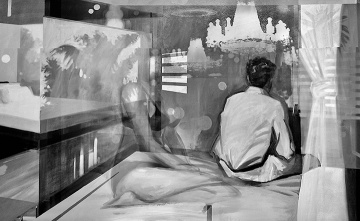
Sheldon Greenberg
Sheldon Greenberg - Cinéma Vérité
November 20, 2019 - January 25, 2020
In Cinéma Vérité, Greenberg experiments with painting as film by repeating images and strips of information that translate into a moment of time. Images sometimes are overlapped or erased, diffused and become something other than reality, like a memory or a dream. Greenberg's unique oil paintings on paper are composed as a digital palimpsest subsequently printed and mounted on aluminum.

Damian Elwes
Artist Studios: From Picasso to Kusama
September 12, 2019 - October 26, 2019
In the 1940s, Henri Matisse advised young artists to make copies of their favorite paintings. Nearly half a century later, Damian Elwes decided to follow his advice with a twist. "I went to Paris and made paintings of the studios of my favorite artists," Elwes says. What began as a way of learning from deceased masters—including Matisse—has developed into a vast body of visually- and conceptually-rich work to be exhibited in a solo show at Modernism Gallery in September.
Elwes has painted the studios of great artists ranging from Claude Monet and Paul Gauguin to Pablo Picasso and Yayoi Kusama to Roy Lichtenstein and David Hockney. His lush canvases not only reference their work aesthetically but also excavate their creative processes by meticulously reconstructing spaces that no longer exist. To research each artwork, Elwes delves deeply into history, scrutinizing dozens of photographs and literary sources as well as the masters' own paintings. He also seeks out the buildings where the artists' studios were once situated. In the case of Matisse, his sleuthing resulted in the rediscovery of the house in Collioure where the artist invented Fauvism in 1905. In others he successfully reconstructed the original arrangement of objects and furniture.
"The sense of painterly well-being that pervades [Elwes' canvases] comes from painstaking research," explains the art critic Anthony Haden-Guest. "Elwes wants the viewer to feel he is witnessing creation... to feel what it is like to inhabit each of these painters."
For Elwes, there's also the conviction that these studios are found compositions. "These people were so visual that even the negative space has been thought about," Elwes observes. "So what I'm doing is painting thousands of still lives laid out for me by the most creative minds of the last century."
Picasso's many studios, as painted by Elwes, are emblematic. Included in this exhibition will be a special installation of the panoramic eight-panel painting of Picasso’s studio at Villa La Californie, Cannes, 1956. Elwes spent more than twelve years creating this monumental, immersive painting, which depicts hundreds of works of art that Picasso worked on in that year.
In historical terms, Elwes' canvases represent an invaluable contribution to the understanding of how some of the 20th Century's greatest artists were influenced by their physical surroundings. In conceptual terms, the paintings are absolutely contemporary, reactivating familiar masterpieces through recontextualization, as has been achieved in different ways by Roy Lichtenstein, John Baldessari, Jeff Wall and Cindy Sherman.
Damian ELWES (born 10 August 1960) is a British artist who lives and works in Santa Monica, California. His work has been exhibited in galleries and museums across America and Europe, and was most recently the subject of a retrospective at the Musée en Herbe, Paris, in 2018.
The public is cordially invited to attend an opening reception on Thursday, September 12th, from 5:30-8PM.
image: Yayoi Kusama’s Studio (Tokyo, 2012), 2018, acrylic on canvas, 60 x 84 inches
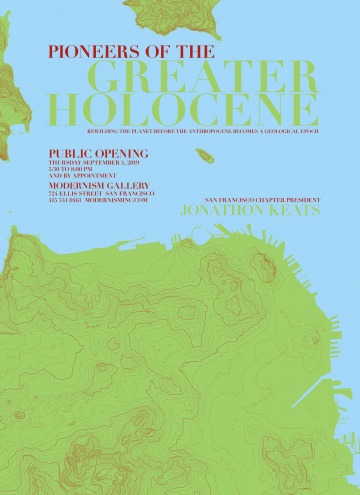
Jonathon Keats
Pioneers of the Greater Holocene
September 5, 2019 - September 5, 2019
GRASSROOTS INITIATIVE WILL TERRAFORM CITIES TO QUASH THE ANTHROPOCENE
Pioneers Of The Greater Holocene Will Launch In San Francisco On September 5th – Modernism Gallery Will Host Debut Event – Global Expansion Will Be Coordinated By New University Institute
August 12, 2019 – As the International Union of Geological Sciences assesses human impact on the planet, determining whether our species has triggered a new geological epoch, a grassroots organization has begun a global effort to give back Earth's crust to all forms of life. The Pioneers of the Greater Holocene will survey spaces shared by humans and other organisms, documenting symbiotic living arrangements as inspiration for future ecosystems, while simultaneously collaborating with non-human species to renegotiate the realms that Homo sapiens dominates today. "The International Union of Geological Sciences is expected soon to proclaim a new epoch dubbed the Anthropocene," says experimental philosopher Jonathon Keats, founding president of the Pioneers. "While their work is laudable, we need to take it as a challenge. We should do all we can to protect and promote the Holocene, the geological epoch we inherited."
With the launch of a San Francisco chapter on September 5th, the Pioneers will systematically catalogue places in the Bay Area where attributes of the Holocene still endure, from Muir Woods to the weeds growing out of Mission District sidewalk cracks. These will not only serve as models for Holocenic revival elsewhere in the world, but also may provide scientific grounds for remaining within the current epoch as we contend with Anthropocenic excess.
"Geologists have a fixed procedure for deciding when a new epoch begins," Mr. Keats explains. They must identify a material change in Earth's strata – such as the global impact of an asteroid strike – and then stake out geological evidence of the transition with a golden spike.
"Until the spike is struck, we have an opportunity to preserve the Holocene by curtailing use of Anthropocenic substances such as industrial fertilizers, fly ash and plastics, and changing the socioeconomic systems that bring environmental ruin. We have the potential to bound the human stratum, and perhaps even to remediate it, putting the Anthropocene behind us as an unfortunate geological interlude."
To offset the Anthropocene, and to foster ecosystems where all life can thrive, the Pioneers will collaborate with plants, fungi and bacteria to rewild the planet. In San Francisco, a city undergoing rapid development, the organization will distribute seed packets containing native grasses that will take root wherever people spread them, from empty lots to busy streets. Over time, these grasses will provide the groundwork for forests to flourish within the urban matrix, not as decorative features for humans but as habitats where all species meet as equals. The organization will also provide a special nutrient mix for lichens, symbiotic organisms capable of transforming concrete into soil while also purifying the atmosphere. "We can't direct how this formula may be washed over skyscrapers, any more than we can officially sanction appropriation of jackhammers to plow through highway asphalt and plant the interstates with grass," says Mr. Keats. "The Bay Area has a reputation for disruption. Preventing a new epoch by re-terraforming the planet is the ultimate disruptive act."
Eventually comprising a global network of concerned humans and other organisms from all phyla, the Pioneers are expected to become a force of nature. Members will also actively support environmental scientists through their documentation of Holocenic ecosystems they find and create, contributing photographic records to the archive of a new Institute for the Greater Holocene. Opening in the fall of 2020, and hosting a major exhibition on life after the Anthropocenic interlude, the Institute will be situated at a major state university, the name of which will soon be released.
"The Holocene began with the end of the last ice age 11,700 years ago," observes Mr. Keats. "Since interglacial periods typically last 40,000 years, we should be able to enjoy our epoch for another twenty-five to thirty millennia. This layer of crust we live on is really quite pleasant. We can probably sustain it, and be sustained by it, if we don't give in to Anthropocenic fatalism."
...
The Pioneers of the Greater Holocene will hold a special launch event on Thursday, September 5th from 5:30 to 8:00 at Modernism Gallery, 724 Ellis St., San Francisco, CA. Visits can be arranged by appointment through September. For more information, call 415/541-0461, email info@modernisminc.com, or visit www.modernisminc.com/artists/Jonathon_KEATS/
...
Acclaimed as a "poet of ideas" by The New Yorker and a "multimedia philosopher-prophet" by The Atlantic, Jonathon Keats is an artist, writer and experimental philosopher. His conceptually-driven interdisciplinary projects explore all aspects of society through science and technology. In recent years, he has installed a camera with a thousand-year-long exposure time – documenting the long-term effects of climate change – at the Arizona State University Art Museum; launched a reciprocal biomimicry initiative – allowing non-human species to benefit from human technologies – at Bucknell University; opened a photosynthetic restaurant serving gourmet sunlight to plants at the Crocker Art Museum; and installed a cosmic welcome mat – greeting beings from throughout the universe – at the International Astronautical Congress. Exhibited internationally, Keats's projects have been documented by PBS, Reuters, and the BBC World Service, garnering favorable attention in periodicals ranging from Science to Flash Art to Slate to The Economist. He is the recipient of multiple Yaddo and MacDowell Fellowships, and has lectured at institutions including Stanford University, the Ecole Polytechnique Fédérale de Lausanne (EPFL), and the Los Angeles County Museum of Art (LACMA), which awarded him a 2015-16 Art + Technology Lab Grant. His latest book, You Belong to the Universe: Buckminster Fuller and the Future has recently been published by Oxford University Press, which also published his previous book, Forged: Why Fakes Are the Great Art of Our Age. He was recently the Black Mountain College Legacy Fellow at the University of North Carolina - Asheville, and is currently a Research Fellow at the Nevada Museum of Art's Center for Art + Environment, a Polar Lab Artist at the Anchorage Museum, and an Artist-in-Residence at both the Fraunhofer Institutes in Germany and UC Berkeley's Sagehen Creek Field Station in California. A monograph about his art is forthcoming from the Anchorage Museum and Hirmer Verlag. He is represented by Modernism Gallery in San Francisco.
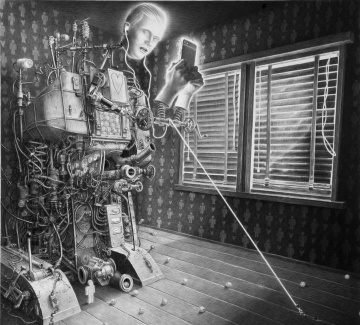
Laurie Lipton
Ex Machina
July 10, 2019 - August 31, 2019
Modernism is pleased to present its first one-person exhibition of drawings by Los Angeles-based artist Laurie LIPTON.
“In intricate drawings, Lipton seductively leads us into the drama of a fun house world where technology has gone wild. Her artistic vision is unique in contemporary art and can be easier associated to the apocalyptic cinematic vision of Ridley Scott’s BLADE RUNNER (1982) and Terry Gilliam’s BRAZIL (1985)”.
—Robert Flynn Johnson, Curator Emeritus, Achenbach Foundation for Graphic Arts, Fine Arts Museums of San Francisco
Lipton’s work presents unflinching commentary on the complexities of modern life, both in society at large and for individuals, including the horrors of war, alienation caused by technology, and our “post-truth” world where everything washes over us like fiction.
The public is cordially invited to attend an opening reception on Wednesday, July 10th, from 5:30-8PM.
To read the full press release please visit our website.
FOR FURTHER INFORMATION CALL: 415/541-0461 / FAX: 415/541-0425, OR EMAIL TO: info@modernisminc.com.
HI-RES IMAGES AVAILABLE ON REQUEST.

Peter Sarkisian
Videomorphic Figures
July 10, 2019 - August 31, 2019
Modernism is pleased to present a solo exhibition of recent works by Peter SARKISIAN, a Santa Fe-based new-media artist.
All of Sarkisian’s work is grounded in the idea that video, in it’s ubiquitous and most popular form, is an experientially void medium, and that by depriving ourselves of experience in favor of information-based images, we have become unable to grasp the meaning of consequence or to coexist with mutual understanding. His installations therefore attempt to steer the world’s most influential medium back on a collision course with the viewer in order to reintroduce an element of experience to the viewing process. If the filmmaker’s traditional goal is to distract viewers through the suspension of self-awareness, then Sarkisian’s goal is to create a sense of heightened self-awareness by engaging the viewer in constructed environments that blur the line between what is real and what is mediated.
"The Videomorphic figures—a phrase Sarkisian coined to
describe the video/sculptural hybrid form—are comprised of
3D printed forms onto which animated motions and gestures are projected. Although the robots are noteworthy in part because of their overly cartoon-like compositions, the increasing sophistication of Sarkisian’s projections situates them in a place of the uncanny, where it is easy to reassure oneself at one moment that these objects have not and can never be alive, while still being lured into occasional moments of doubt when the combination of solid form and lifelike motion let us glimpse a world of the future, when actual robots, in the form of charming humanoids will be our near-constant companions."
—Dan Cameron, Curator (Excerpt from catalogue essay for the exhibition Sarkisian & Sarkisian, organized by the Orange County Museum of Art, 2014)
WATCH VIDEO OF THE VIDEOMORPHIC FIGURES at https://vimeo.com/79895782
The public is invited to attend an opening reception on Wednesday, July 10, from 5:30 to 8pm.
FOR FURTHER INFORMATION CALL: 415/541-0461 / FAX: 415/541-0425 OR EMAIL: info@modernisminc.com HI-RES IMAGES UPON REQUEST.
Philippe Gronon
Versos
May 16, 2019 - June 29, 2019
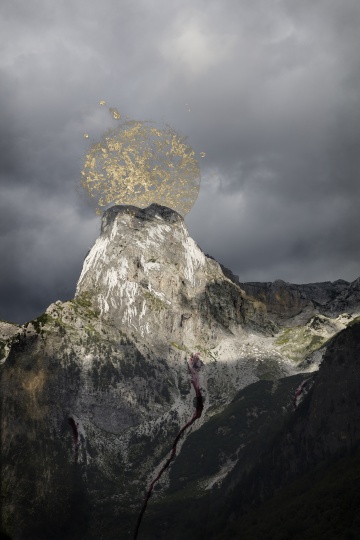
Elena Dorfman
Still Lovers and Transmutations
April 11, 2019 - May 10, 2019
Reception for the artist Thursday, April 11, 2019 from 5:30 - 8:00pm

Richard P. Doyle, Jr. and Mark Ulriksen
Game Time
April 11, 2019 - May 10, 2019
Reception for the artists Thursday, April 11, 2019 from 5:30 - 8:00pm

Mel Ramos
Memorial Exhibition
March 7, 2019 - April 6, 2019
Modernism is pleased to present a Memorial Exhibition celebrating the life and work of Mel RAMOS.
Opening Reception Thursday, March 7, 2019 from 5:30 - 8pm
Mel Ramos
Memorial Exhibition
March 7, 2019 - April 6, 2019
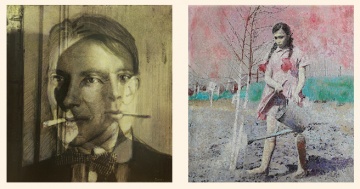
Valentin Popov & Victor Sydorenko
Collected Moments
February 20, 2019 - April 1, 2019
Reception for the artists Wednesday, February 20th, 6-8pm at Modernism West/Foreign Cinema. Hours: M-F 6-10pm, Sat-Sun 11am-10pm. Call 415-648-7600 to confirm access.
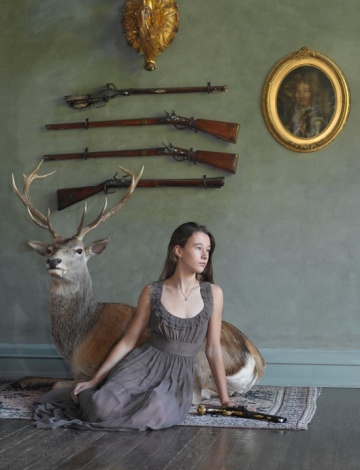
Lindsay McCrum
Chicks with Guns
January 10, 2019 - February 23, 2019
Reception for the artist is Thursday, January 10, 5:30 - 8 pm
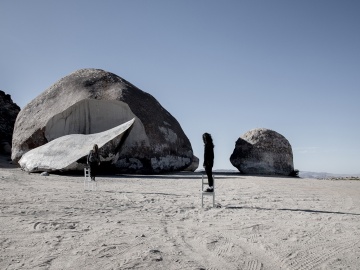
ALEXANDMUSHI
Push Me Pull You
November 8, 2018 - December 22, 2018
Opening reception Thursday, November 8, 5:30-8pm
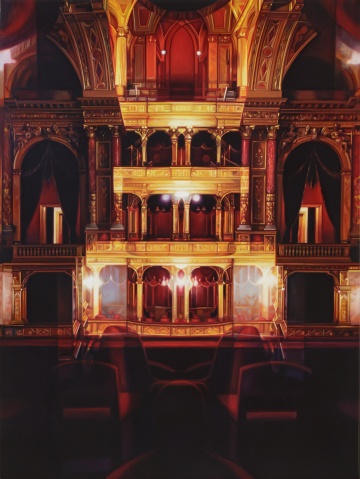
Patti Oleon
Somewhere Else
November 8, 2018 - December 22, 2018
Opening reception Thursday, November 8th, 5:30-8pm

Charles Arnoldi
Recent Paintings
September 12, 2018 - October 27, 2018
Reception for the artist Wednesday, September 12 from 5:30-8pm

Shawn HUCKINS
Fool's Gold
July 11, 2018 - September 8, 2018
The public is cordially invited to attend an opening reception on Wednesday, July 11th, from 5:30-8PM.
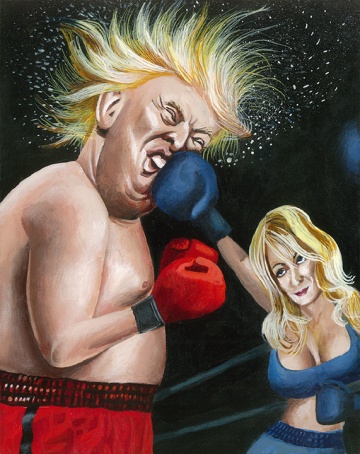
Mark ULRIKSEN
Something in the Air
July 11, 2018 - September 8, 2018
Reception for the Artist Wednesday, July 11 from 5:30-8 PM
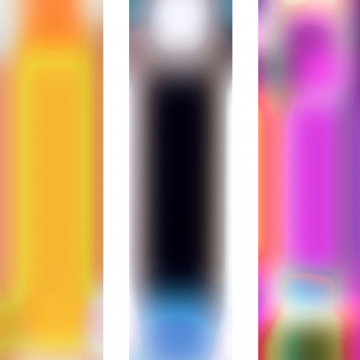
Bill Kane
Emanations
June 28, 2018 - September 3, 2018
Reception for the artist June 28, from 6-8PM at Modernism West/Foreign Cinema. Hours: M-F 6-10pm, Sat-Sun 11am-10pm. Call 415-648-7600 to confirm access.
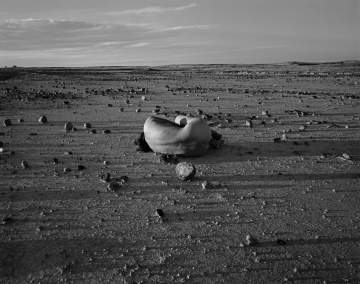
Judy Dater
Personas: A survey of works from 1965-2016
May 10, 2018 - June 30, 2018
Opening reception May 10 from 5:30-8PM
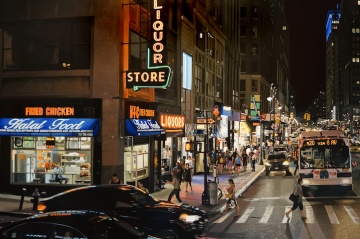
Seth Tane
Trading Places
May 10, 2018 - June 30, 2018
Opening reception May 10 from 5:30-8PM
Jacques VILLEGLÉ
Traces: Décollages from 1956-2000
March 15, 2018 - April 28, 2018
Opening reception Thursday, March 15, 5:30-8pm

 Back to all Member Galleries
Back to all Member Galleries


